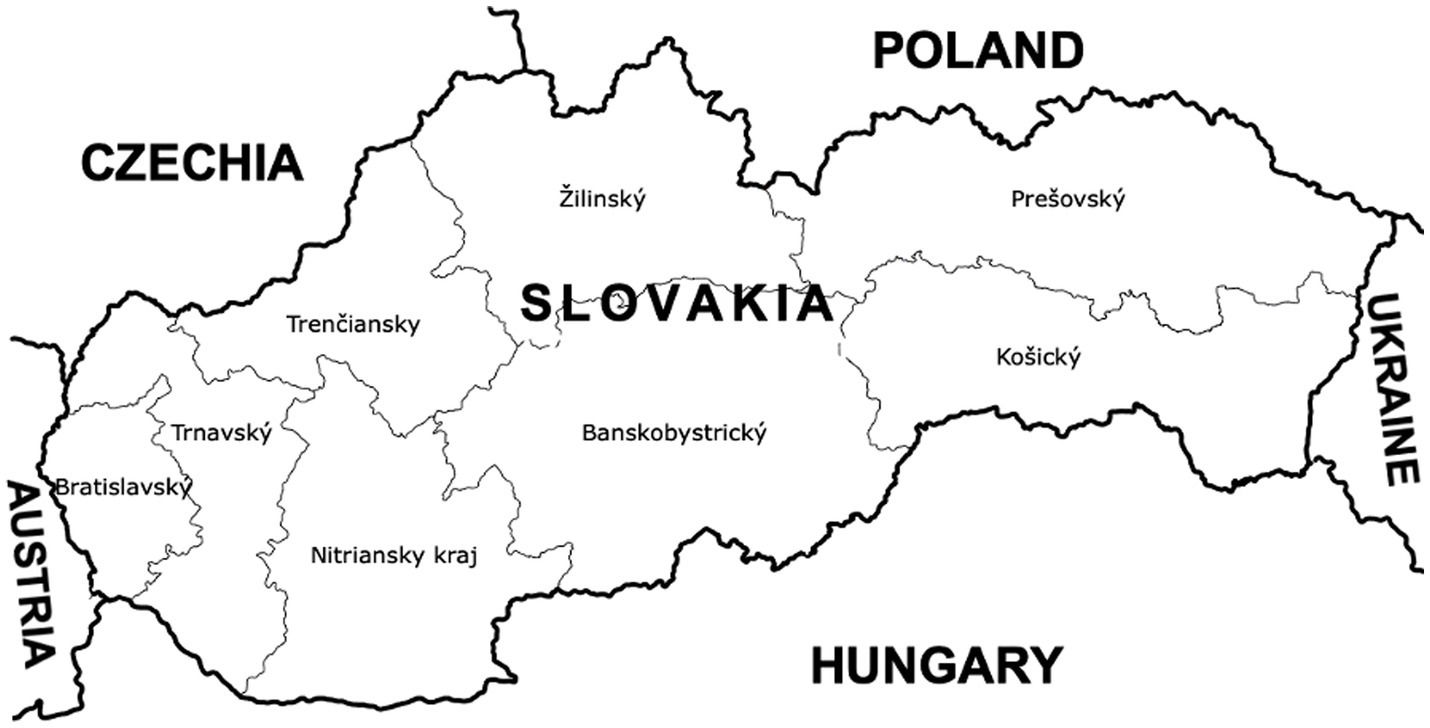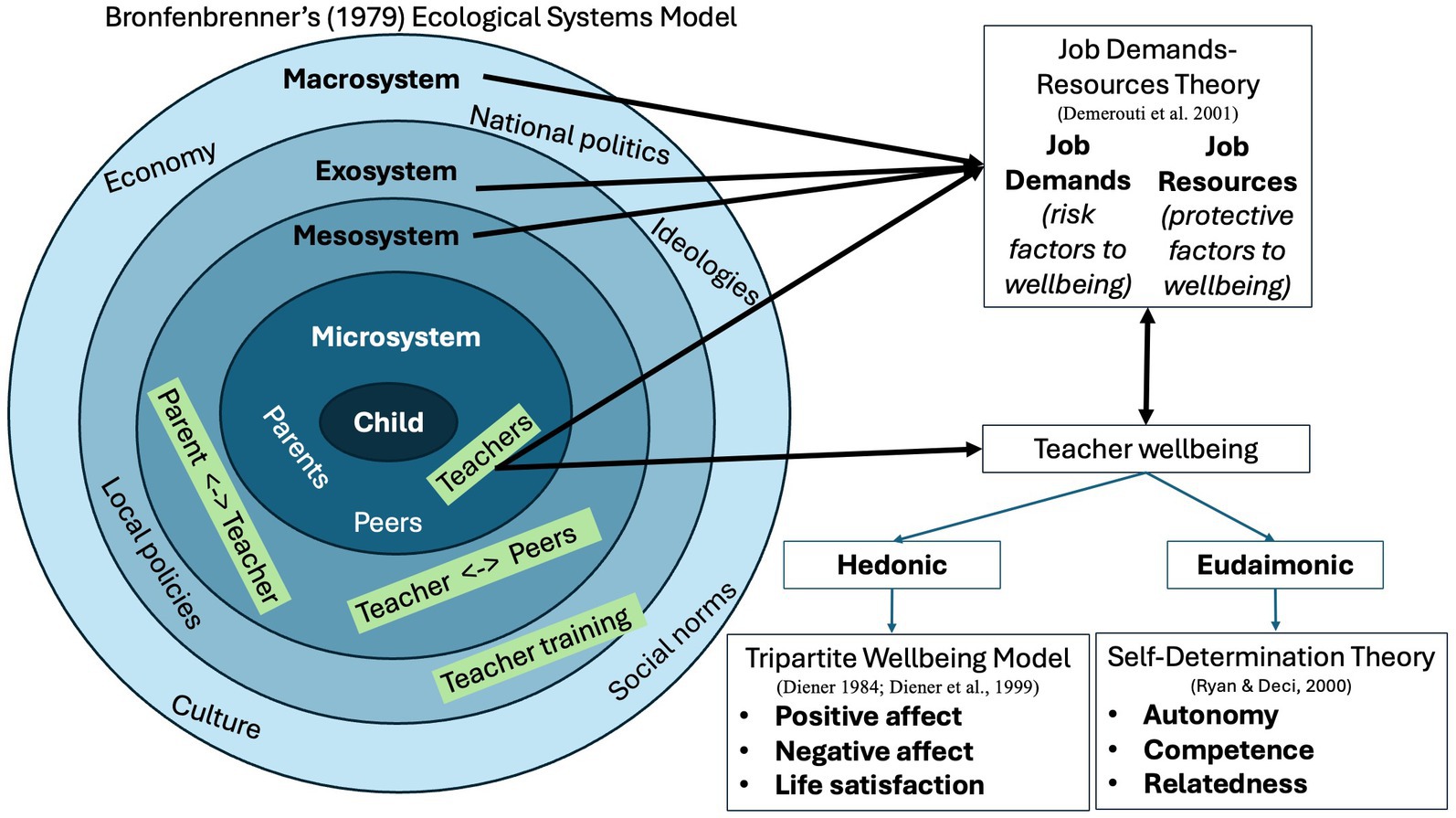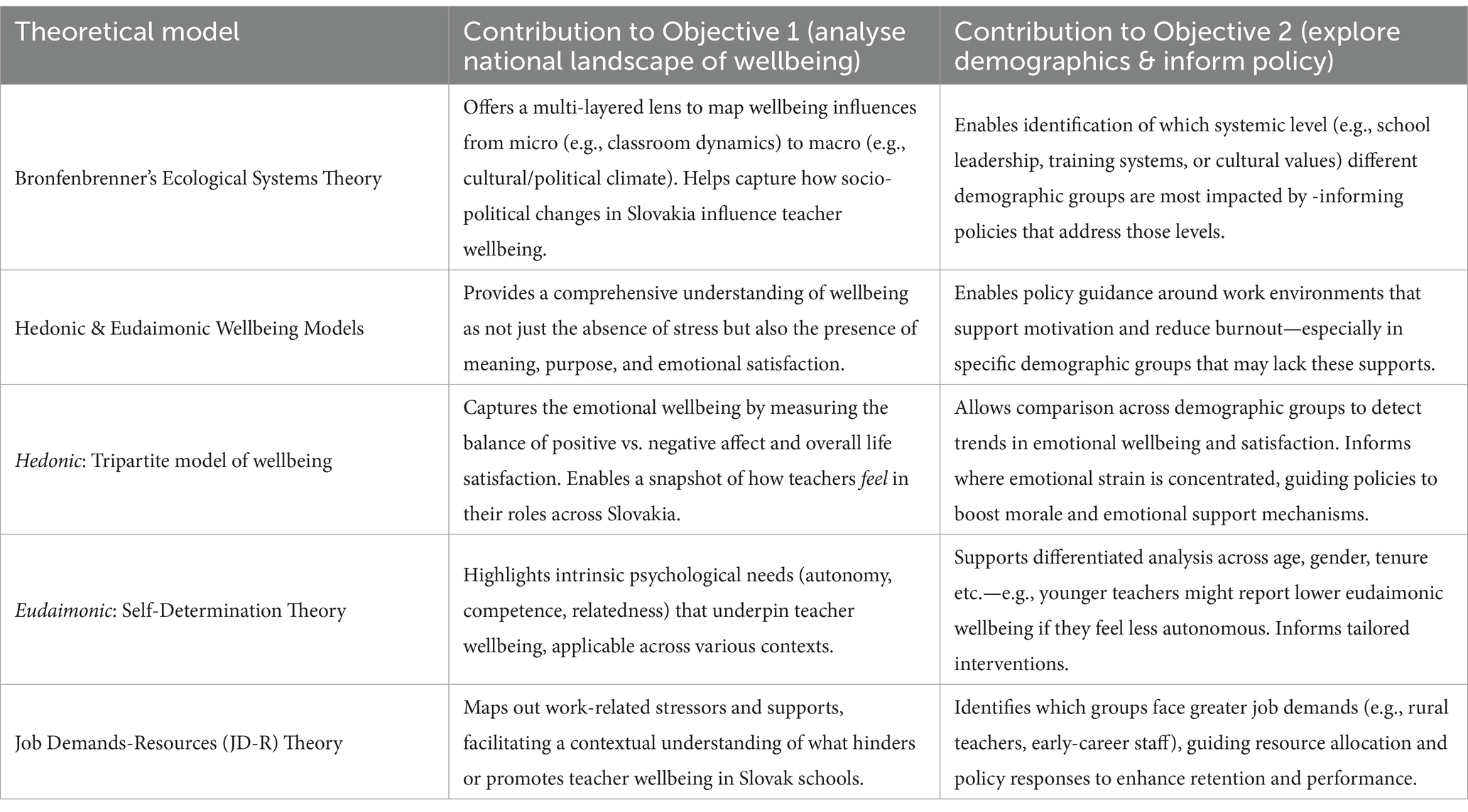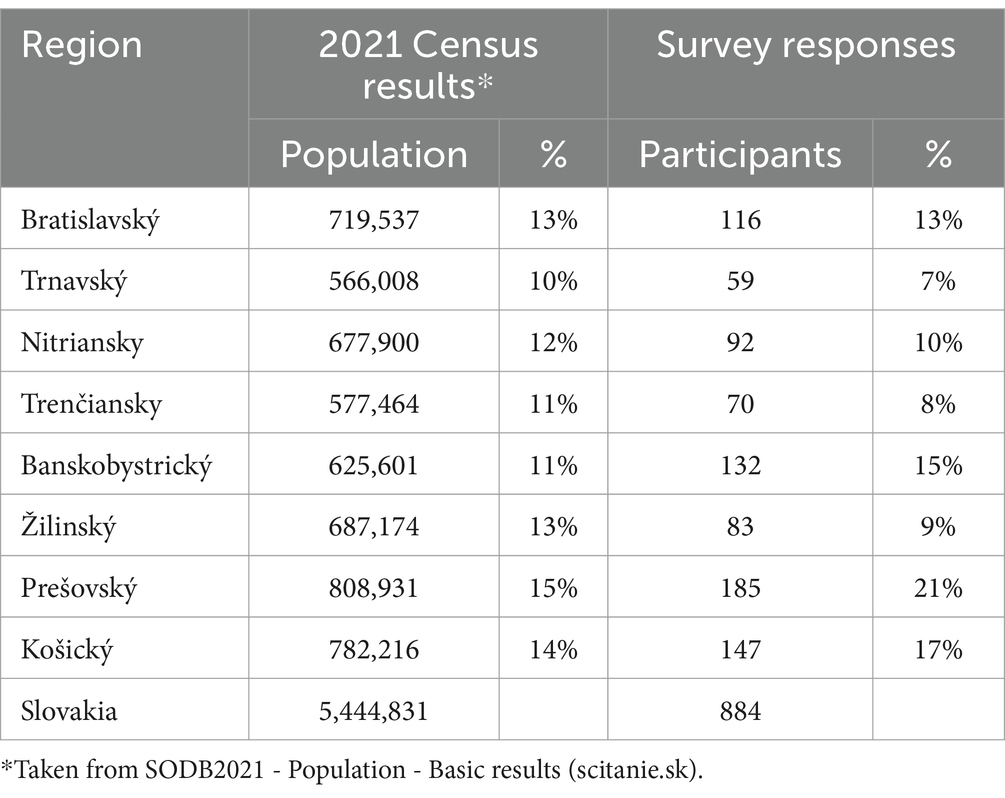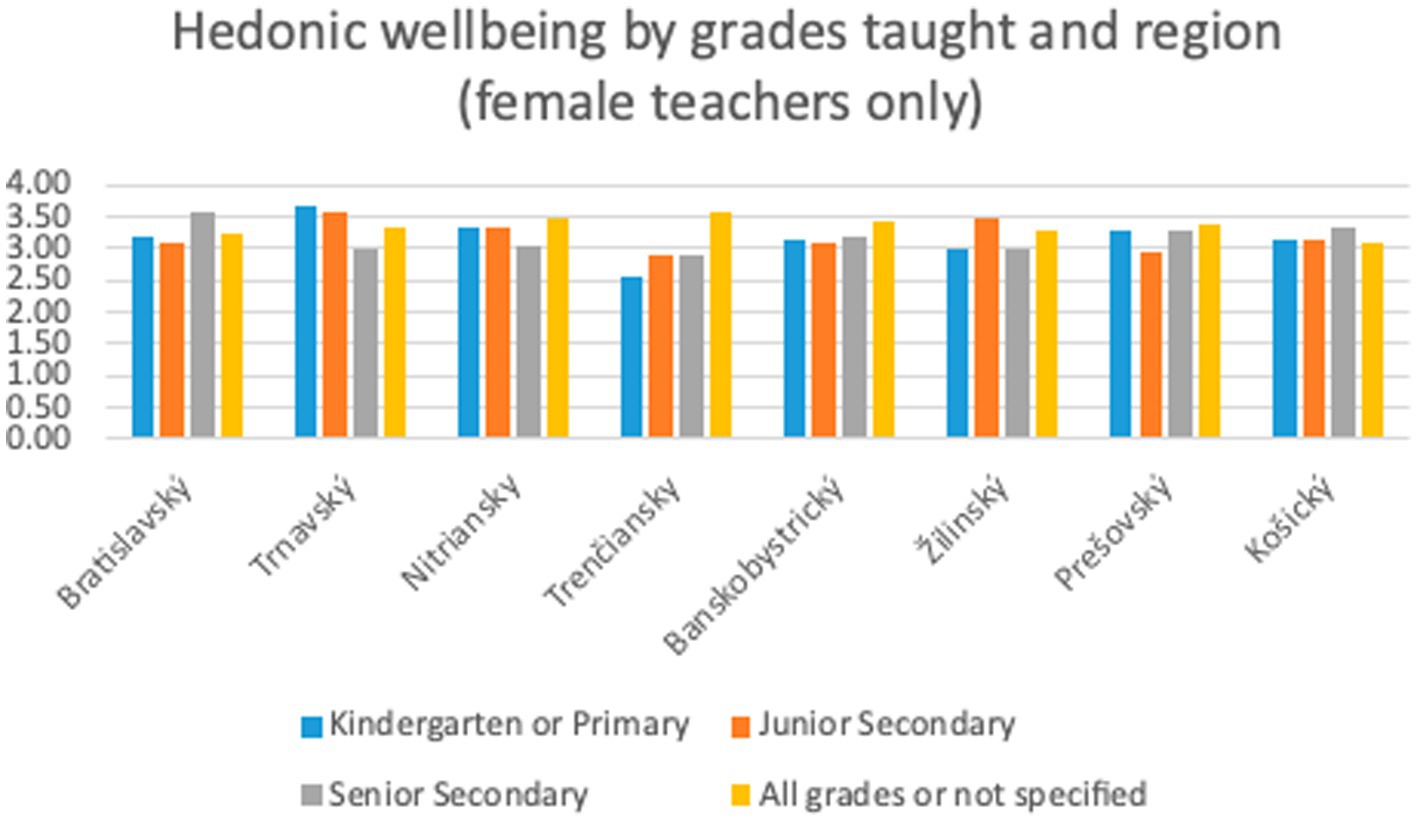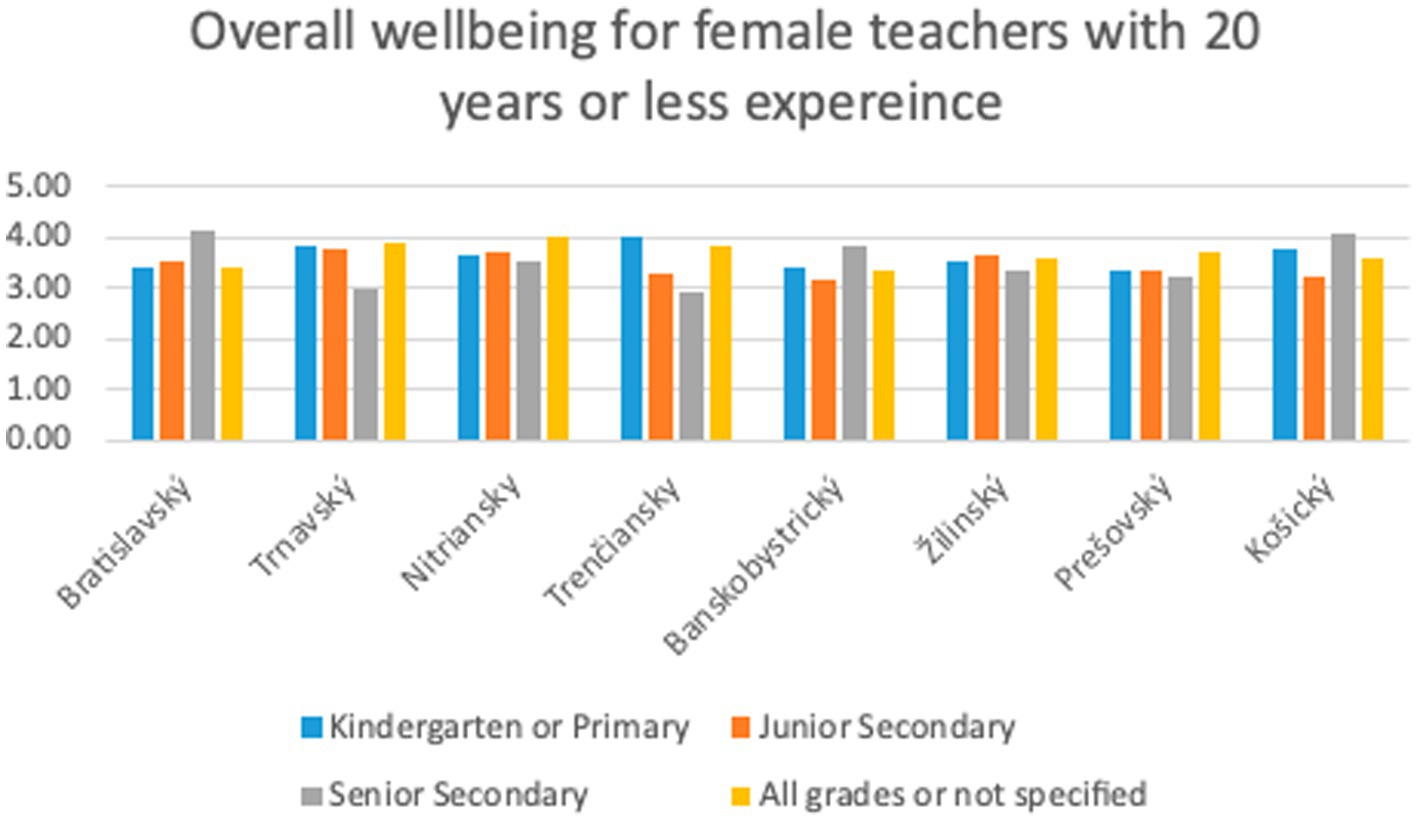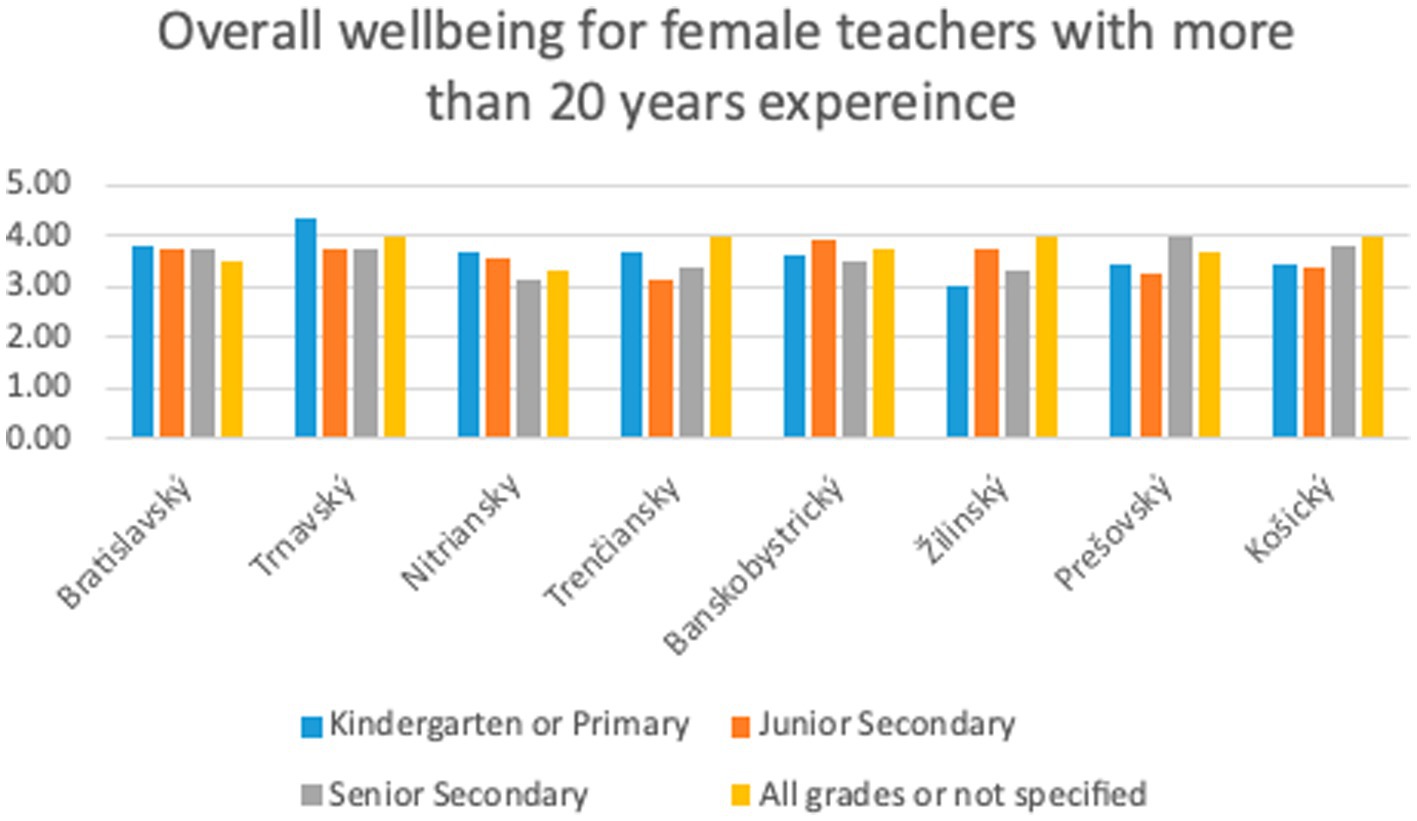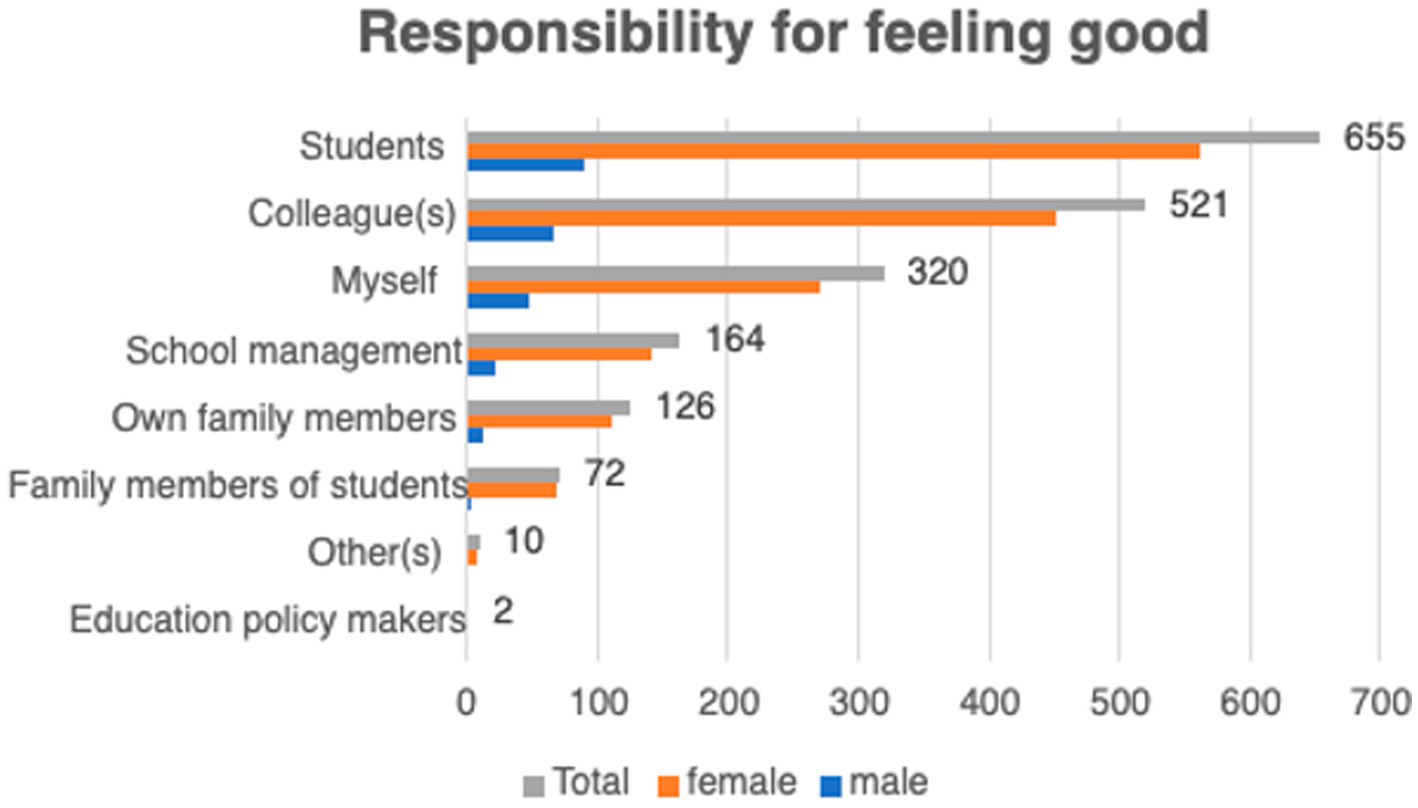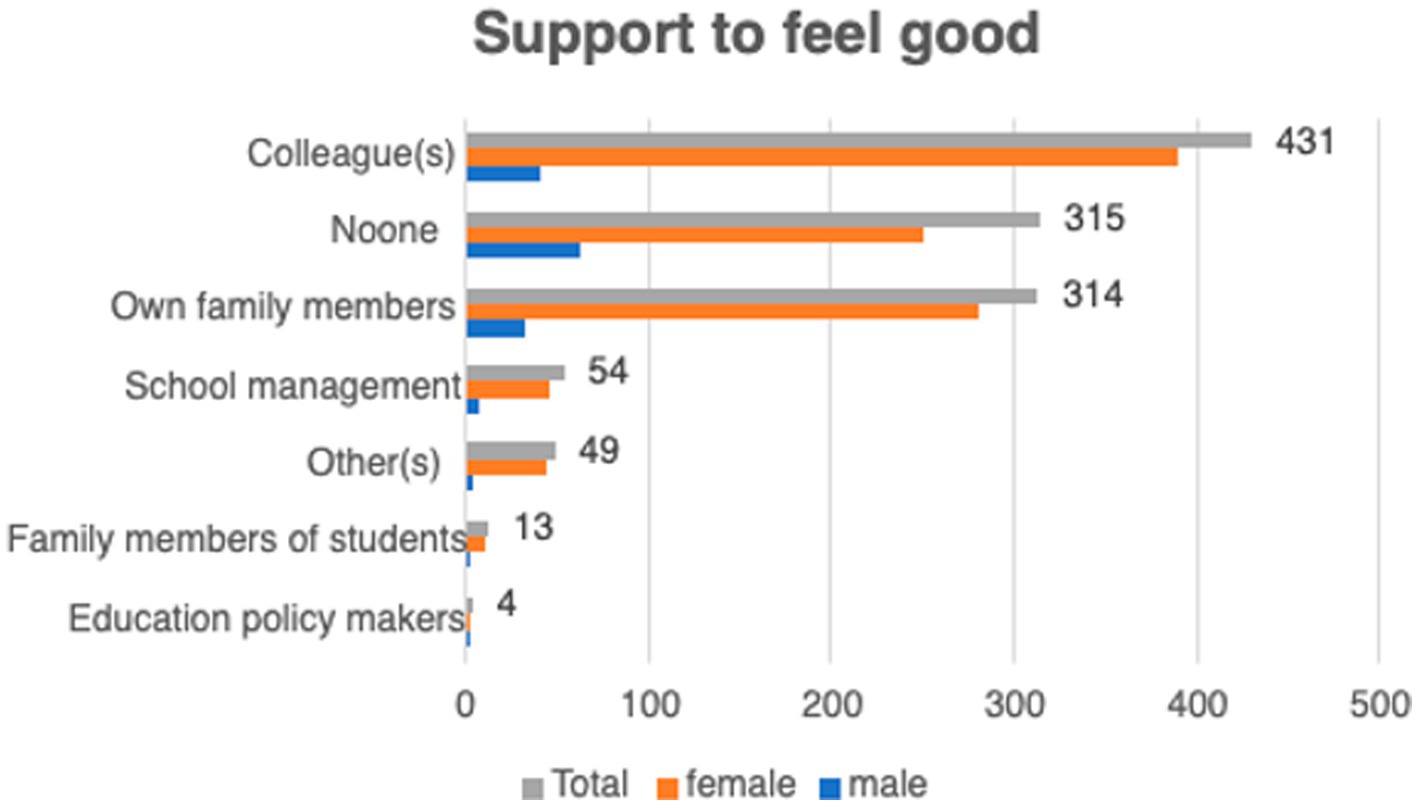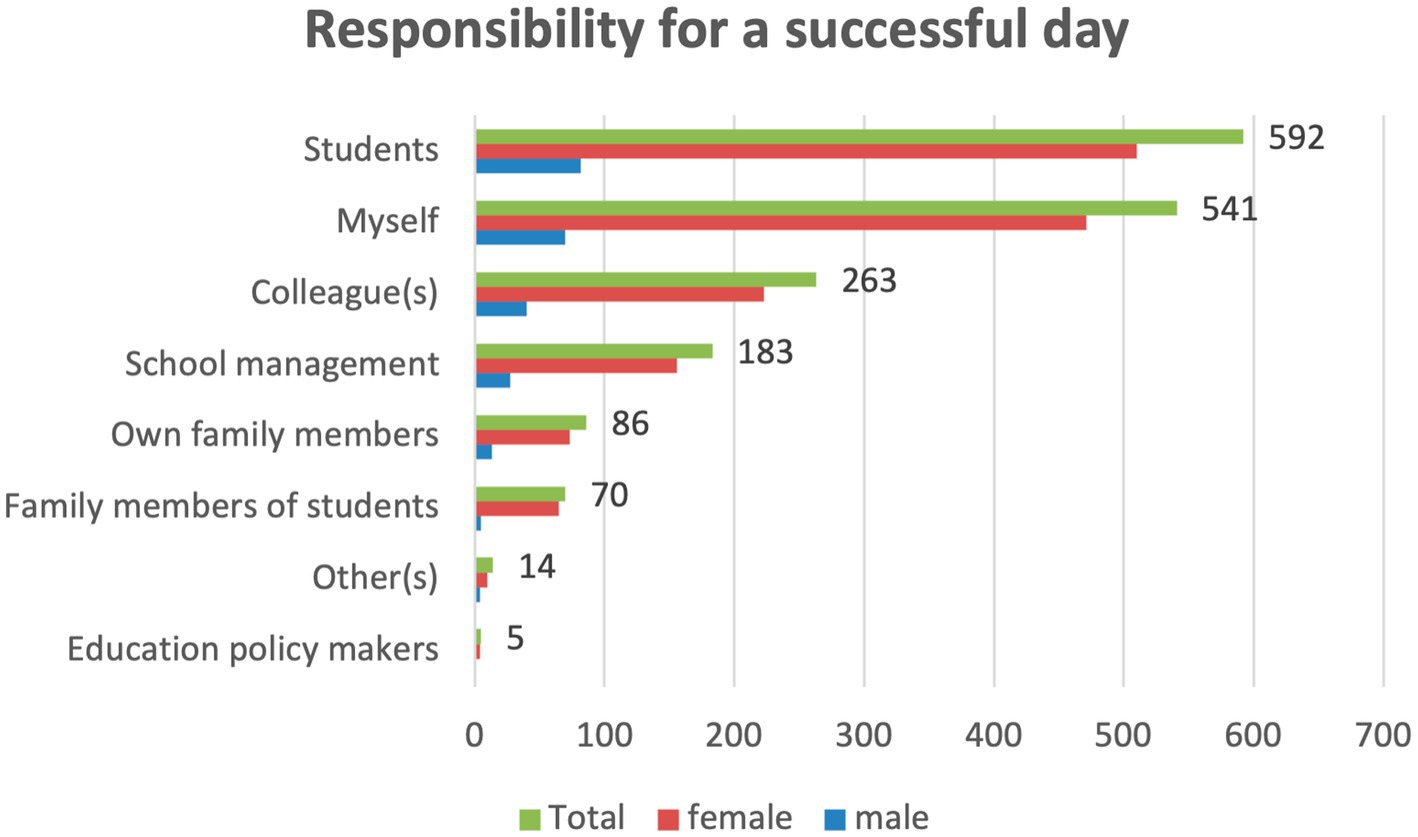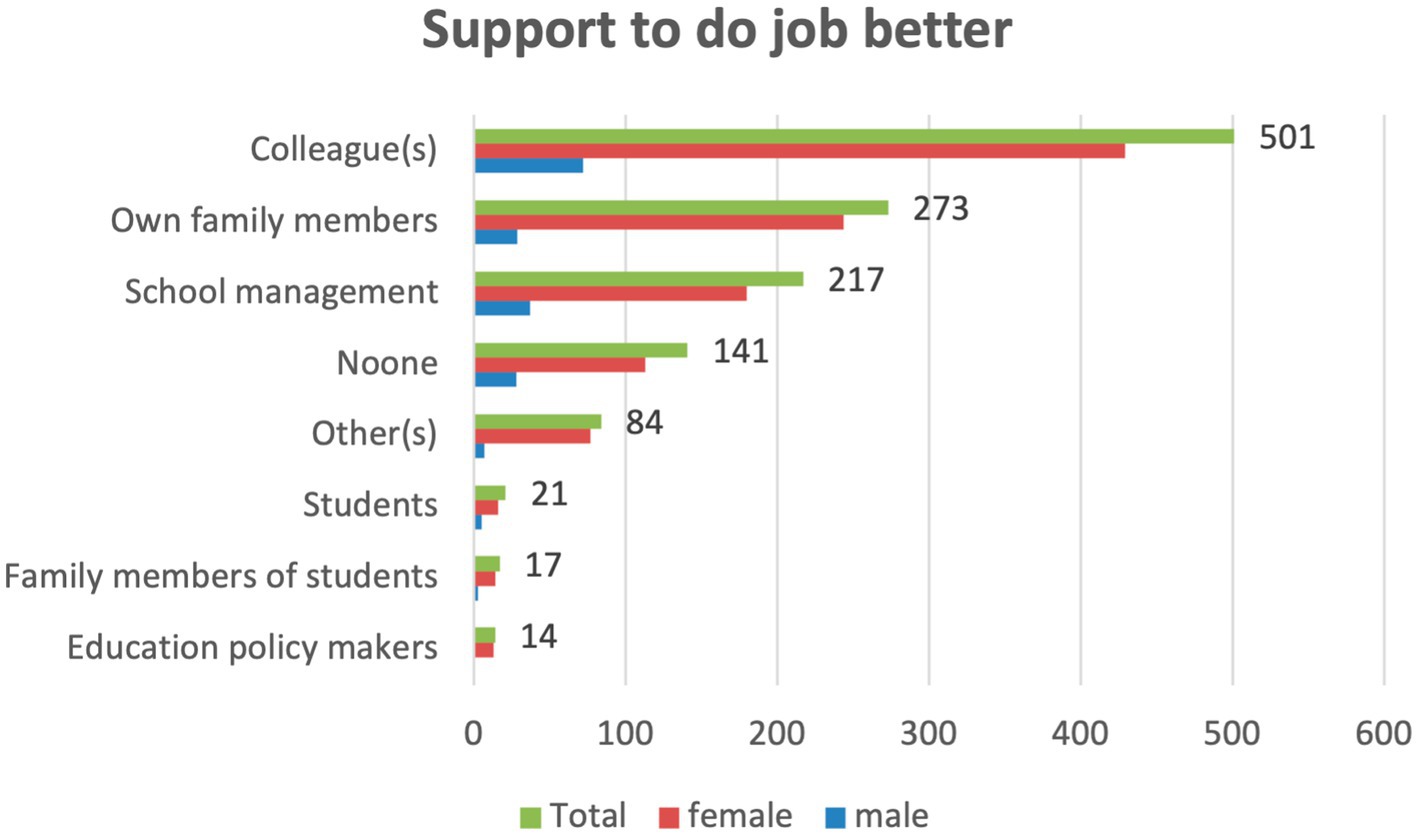- 1School of Education, University of Exeter, Exeter, United Kingdom
- 2Institute of Applied Psychology, Faculty of Social and Economic Sciences, Comenius University, Bratislava, Slovakia
Introduction: This study explores subjective wellbeing, resilience, and sources of support in the teaching profession, which sits at the heart of communities and society. Teachers need to manage their own wellbeing while playing a critical role in fostering young people’s wellbeing, equipping them for the challenges of the present and future. Slovakia offers an underexplored and critical context for this study, as its education system is in the early stages of recognising the importance of teacher wellbeing and lacks systematic supports for state employees. Additionally, the nation is uniquely positioned within a geopolitical landscape that intensifies stressors on its population.
Methods: We administered a brief online survey to a nationwide sample of teachers in Slovakia (n = 884). Rather than collapsing wellbeing into a single metric, we apply a simple theoretical model that distinguishes self-perceived competence and affect, providing a more comprehensive representation of teacher wellbeing.
Results: Our findings reveal distinct patterns based on gender and years of service in how teachers experience hedonic wellbeing (happiness and satisfaction) and eudaimonic wellbeing (optimal functioning and meaningfulness). Relationships—both within and beyond the profession—emerge as critical determinants of wellbeing, surpassing formal support structures in importance.
Discussion: These results inform recommendations for professional development initiatives grounded in a national perspective, with the potential to enhance teacher support networks and address systemic gaps. By mapping teachers’ social worlds, this study opens pathways for targeted interventions to improve the wellbeing of educators in Slovakia and beyond.
1 Introduction
Wellbeing indicates personal and professional functioning at individual and societal levels. The ongoing global challenges war conflicts, climate-related disasters, economic crises, and pandemics such as Covid-19, continue placing wellbeing at risk (e.g., De Rose et al., 2023; Fernandez-Urbano and Samuel, 2024). In response to these challenges, the World Health Organisation (WHO) coordinated the endorsement of Geneva Charter for Wellbeing in 2021 and the Global Wellbeing Framework in 2023. Through these initiatives, the WHO gained commitment from its member countries to promote societal wellbeing across the globe.
The Global Wellbeing Framework prompts decision makers to build societal wellbeing by adopting six strategic directions in the support of: 1. Ecosystems; 2. Equity, inclusion, and solidarity; 3. Equitable economies; 4. Health care and health promotion; 5. Broadly available digital systems; and 6. Measuring and monitoring wellbeing (World Health Organization, 2023). This article focuses on the last one. Measuring wellbeing is not a new idea, and indeed, wellbeing has been monitored by sociologists, psychologists and economists aiming to understand how societies are doing at national level and in comparison to other countries. To illustrate, OECD Better Life Index, Gallup Wellbeing Survey, European Social Survey, and many other tools collect wellbeing data in regular cycles, allowing for a long-term comparison of trends within and across nations (e.g., Blanchflower and Bryson, 2024). Slovakia takes part in these reports and scores at varied ranks. The OECD (2020) Better Life Index places Slovakia 5.5 in the middle between Hungary 3.9, Poland 4.2 and Czechia 6.7, Austria 7.8 in terms of Life satisfaction (0-10-point scale) with no data for Ukraine. The Gallup Wellbeing Survey (Helliwell et al., 2024) placed Slovakia 45th, after Austria 14th, Czechia 18th, and Poland 35th, but before Hungary 56th and Ukraine 105th. European Social survey has old data 2012/2013 so preludes the position before the conflict in Ukraine which borders Slovakia. These tools assess the objective (e.g., life expectancy, income, education levels) and subjective (e.g., life satisfaction, happiness) indicators of wellbeing. Much of the research is sponsored by commercial rather than state employers where underreported gains to spend may be less politically advantageous than direct, observable but shorter-lived gains such as tax cuts, welfare payouts.
Similar to decision makers across the globe, countries such as Italy (Facchinetti and Siletti, 2022) and business organisations (e.g., IBM, Booking.com) started to recognise the importance of employee’s wellbeing. 68% of Human Resources leaders have shifted their priorities towards employee’s wellbeing and resilience (Executive Networks, 2022), realising that employees who feel good at work help build a resilient organisation with higher performance, better relationships, and better retention (e.g., Gelencsér et al., 2023; Horváthová et al., 2021; Suárez-Albanchez et al., 2022). Therefore, it is not surprising that wellbeing programmes and initiatives continue growing. Globally, the corporate wellbeing market size of $64.02 billion in 2024 is expected to grow to $94.74 billion by 2032, representing an approximate 50% increase in the next 8 years (Fortune Business Insights, 2024). To ensure investments into wellbeing support are efficient and contribute to building societal wellbeing, it is crucial to measure wellbeing and most of all to understand the wellbeing needs at a more grounded level. The public employee sector also needs to ensure it keeps up with these trends found in the commercial sector.
Here, we would like to make a case for investigating the wellbeing in a specific nationally-funded profession—teaching. In comparison to other professions, teachers in the United States experience poor wellbeing (Doan et al., 2023). Extreme stress and burnout make 55% consider leaving the profession (Jotkoff, 2022), having bearings on the entire education system. Reports from 2021, 2022, and 2023, reveal that teachers continuously report to be twice as likely to experience frequent job-related stress compared to other working adults (Doan et al., 2023). The United Kingdom reports confirm these statistics especially for special education needs teachers, who report twice as high job-related mental illness compared to the average levels shown for other professionals (Jerrim et al., 2020). Interestingly, similarities between teacher and other working adults’ general life-satisfaction, depression, anxiety, and broader wellbeing outcomes (Jerrim et al., 2020) indicate school environment as a particularly interesting context for an in-depth investigation of wellbeing.
Further examination revealed differences within the teaching profession in the UK with primary and secondary teachers remaining above the national public vs. private average of reported work-related ill-health and mental ill-health amongst professions while head teachers staying is around the occupational average (Jerrim et al., 2020). Figure 1 illustrates the proportion of teachers reporting work-related ill-health and mental ill-health compared to other professions (Jerrim et al., 2020, p. 679, Figure 4).
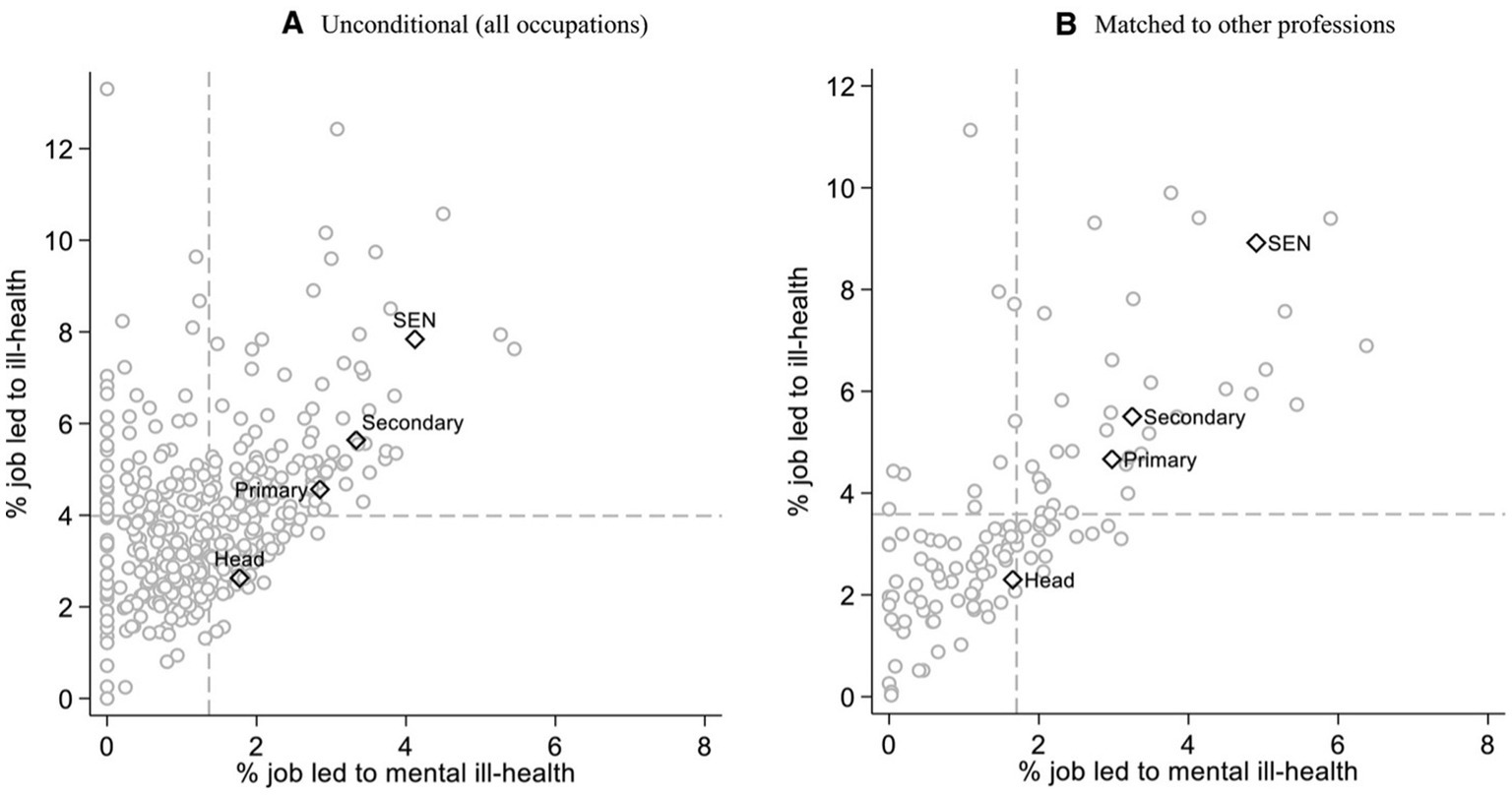
Figure 1. Teachers’ work-related ill-health and mental ill-health vs. other professions. Unconditional results (left panel A) show average outcomes across all occupations without adjustments. Matched results (right panel B) compare each occupation only to similar professional roles, allowing for more controlled comparisons. (Source: Jerrim et al., 2020, p. 679, Figure 4).
These findings indicate that although the general wellbeing and mental health of teachers may be comparable to other professions, the high levels of job-related stress and mental illness calls for a more in-depth investigation within the school context.
More broadly, the wellbeing of teachers relates to research on social indicators in several ways. First, teachers directly contribute to the quality of educational experiences, learning and development of students (Skaalvik and Skaalvik, 2014). Studies have shown that teachers who experience high levels of stress and burnout are more likely to have lower job satisfaction, be absent from work, and provide lower quality instruction (Boyle et al., 2015; Skaalvik and Skaalvik, 2011). Next, the wellbeing of teachers and students is closely connected and higher distress in teachers is associated with students’ poorer wellbeing (Harding et al., 2019). Often, teachers are at the forefront of students’ mental health issues being identified (Lowry et al., 2022) and the teacher-student relationship having long-term mental health implications into adulthood (Kim, 2021). Finally, the impact of teacher wellbeing spreads beyond the classroom. Teachers contribute to school culture and the relationships and activities in their communities as well as wider society (Bronfenbrenner, 1979). Teachers can create a positive and inclusive school culture that values collaboration, innovation, and continuous improvement, which can help shape educational policy in the short and longer-term (Darling-Hammond, 2017).
To sum up, teachers’ wellbeing is most directly linked to students’ wellbeing and outcomes. Students achieve better results in schools where teachers perceive their wellbeing positively (Briner and Dewberry, 2007) and where teachers are sensitive to not only their own wellbeing but are sensitive to that of their students (Braun et al., 2020). In these ways, teacher wellbeing contributes to the Quality Education and Good Health and Wellbeing, which are two of the Sustainable Development goals set up by the United Nations (2022) and towards the WHO efforts to promote societal wellbeing.
However, teacher training rarely focuses on developing their skills to support students and this is true for well-established European democracies including Sweden, United Kingdom, Spain and Greece (Byrne et al., 2015; Loinaz, 2019). Therefore, mapping the wellbeing needs of teachers can inform professional development programmes helping them build related skills to facilitate broader gains in the wellbeing of not only themselves and their colleagues but also young people in changing times.
1.1 Measuring wellbeing
The mapping of wellbeing needs is complex as the construct involves objective and subjective elements. In the context of a profession, objective wellbeing measures include employee turnover, absenteeism, time in service and others. Our focus however is on the subjective wellbeing, which reports on “good mental states, and how people experience their lives” (OECD, 2020, p.137). Subjective wellbeing can often hint what the objective wellbeing reports may look like as people’s experiences trigger their actions and may impact physical health (Diener et al., 2017). Existing tools that assess subjective wellbeing at work tend to evaluate cognitive satisfaction with work such as the employee-employer relationships in the Workplace Wellbeing Questionnaire by Parker and Hyett (2011) or take a very specific angle like health and learning opportunities in the Thriving at Work by Porath et al. (2012). Others can get very detailed and impractical as is the case of the 80-items in the Index of Psychological Wellbeing at Work by Dagenais-Desmarais and Savoie (2012). Nevertheless, the range of tools assessing subjective wellbeing in a workplace environment indicates that the perceived quality of life of individuals in an organisation has received greater recognition and attention.
1.2 The Slovak context
This study is positioned in the heart of Europe and targets Slovakia, a country transitioning to democracy since the fall of communism in 1989. Slovakia provides a unique context to investigate societal wellbeing. At the heart of eastern Europe and as a Ukrainian neighbour, Slovakia is facing an unprecedented migration and geopolitical issues that translate to the daily experiences of Slovakians. Figure 2 shows the map of Slovakia, its regions and neighbouring countries.
The estimated population of 150,000 Ukrainians, who arrived in the country since the start of the war (United Nations Refugee Agency, 2024), is meeting with one of the largest pro-Russian and pro-Western societal divide, driven by the strongest Russian propaganda in the Central and Eastern European region (Hajdu et al., 2023). Polarised sentiments have been further fuelled by recent wins of pro-Russian political party SMER and newly elected president, leading to young, educated people leaving the country (Bauerova, 2024). These external migration of ‘brains’ could potentially lead to long-term challenges in progressing Slovakia to a modern and developed country.
One of the potential explanations could be the high presence of what Birzea (2012, p.2) calls ‘residual communism’ represented by behaviours and mindsets that are still present in the democratic society in transition even though the institutions might have transferred. In fact, the substantial reforms that would drive transition to democracy have not been adopted throughout the system, with education and healthcare being neglected the most. Piloting of substantial educational changes started only in September 2023 which provides another opportunity to examine wellbeing as a relatively new concept, predominantly linked with mental illness which retains significant stigma in several post-communist societies (Doblytė, 2020). Systematic wellbeing supports are currently being introduced, targeting literacy around specific mental health issues. Nevertheless, the country has not been immune to the global challenges although the assessments of teachers’ wellbeing is almost non-existent. The only Teacher Wellbeing Index from 2019 reported high levels of stress experienced by teachers (Ďuríková, 2021). Pandemic triggered a number of reports revealing poor mental health in students (e.g., Rutkowska et al., 2021; Slovak Academy of Sciences, 2020) and negative emotional wellbeing in teachers (Ballova Mikuskova and Veresova, 2020). Mapping teachers’ needs amid new geopolitical challenges will be particularly informative for the ongoing educational reform and the future of young people’s education in Slovakia and other post-Soviet nations proximal to the conflict in Ukraine.
2 Theoretical frameworks for teacher wellbeing
Urie Bronfenbrenner’s Ecological Systems Model serves as the framework for our study, emphasising the crucial and multifaceted role teachers play in their students’ lives. The model maps the complexities of societal systems and helps portray the interactions that influence an individual’s development. Rooted in developmental psychology, the simplified ecological systems model places a child in the middle, surrounded by different layers of environments that shape their growth: the microsystem (e.g., teachers, parents, friends), mesosystem (e.g., interactions between microsystems—teacher and parent), exosystem (e.g., interactions between indirect environments—teacher training, local politics) and macrosystem (e.g., ideologies, culture, economy) (Bronfenbrenner, 1979; Bronfenbrenner and Morris, 2007).
Teachers mediate influences from broader systems (e.g., politics, culture) while interacting with parents and peers, making their wellbeing pivotal to student outcomes. Previous research has used this model to map wellbeing influences across systemic layers (e.g., Price and McCallum, 2015), and to track how socio-political decisions on austerity specifically impact teachers’ wellbeing (Hanley et al., 2020). For Slovakia, the model informs how geopolitical contexts and democratic transitions cascade down to teacher wellbeing. At the microlevel, we will map who teachers draw on for support when working with students.
We adopted a broad conceptualisation of wellbeing, encompassing hedonic (e.g., prevailing positive emotions, satisfaction) and eudaimonic (e.g., finding meaning, optimal functioning) dimensions (e.g., McMahan and Estes, 2011; Ryan and Deci, 2001). This approach aligns with well-established tools assessing subjective wellbeing, including the Warwick-Edinburgh Mental Wellbeing Scale (Tennant et al., 2007), the RAND’s State of the American Teacher and the Psychological Wellbeing Scale (Ryff and Keyes, 1995).
We assessed hedonism using Diener’s tripartite model, which measures wellbeing though the frequency of positive relative to negative emotions across life domains (Diener et al., 1999). For eudaimonia, we draw on the Self-Determination Theory (SDT), which underpins the motivation and optimal functioning in social contexts (Ryan and Deci, 2000). According to SDT, fulfilling the needs of autonomy, competence, and relatedness is essential for wellbeing (Ryan and Deci, 2000). This framework is particularly relevant in work contexts, where studies have linked SDT to teacher burnout (e.g., Fernet et al., 2012) and highlighted relatedness as a key protective factor for teachers’ wellbeing (e.g., Haw et al., 2023; Maas et al., 2022).
The framing of our study is complemented by the job demands-resources theory (JD-R; Bakker and Demerouti, 2007; Demerouti et al., 2001), which divides working conditions into job demands (e.g., workload, stress), which require effort and energy, and job resources (e.g., supportive leadership, school climate), facilitating the job performance (Bakker and Demerouti, 2007; Demerouti et al., 2001). Demands can lead to burnout, while resources foster engagement and job satisfaction. Therefore, job demands and resources represent risk and protective factors to wellbeing.
The cross-cultural relevance of the JD-R theory is supported by global studies on teacher wellbeing. For example, a Saudi study identified role conflict and internal locus of control as key factors contributing to burnout (Asfahani, 2024), while in Australia, poor leadership increased job demands and presenteeism, whereas good leadership and support enhanced engagement (McGregor et al., 2016). A Central and Eastern European study, including Slovakia, echoes these findings and highlights interpersonal relationships, workload, teaching tasks and environment as key areas encompassing both stressors (job-demands) and resources (Kovács et al., 2024). Studies in Spain (Mérida-López and Extremera, 2020) and China (Cheng et al., 2023) have shown that emotional regulation and intelligence moderate the balance of job demands and resources, influencing absenteeism and burnout. The Chinese context highlights cultural implications, where student performance reflects teachers’ abilities, adding unique demands (Cheng et al., 2023).
Together, the selected models allow the study to capture both the complexity and specificity of teacher wellbeing in Slovakia. Figure 3 shows how we integrate the models into our framework.
Table 1 maps each of the theoretical models into our key objectives.
Bronfenbrenner grounds the analysis in Slovakia’s unique socio-political history and maps wellbeing influences from micro to macro levels. Hedonic and eudaimonic approaches ensure that wellbeing is treated as multifaceted and not limited to for example stress avoidance (negative affect in Diener’s Tripartite model) but also considering what helps teachers thrive (Self-Determination Theory). JD-R theory bridges theory to practice by mapping where intervention is needed most, considering workload, support, and school context. By integrating the abovementioned frameworks, this study examines how systemic and psychosocial factors interact to shape Slovak teachers’ wellbeing, offering a foundation for targeted interventions.
2.1 Extant knowledge of teachers’ wellbeing in Slovakia
Slovakia offers a unique perspective on teacher wellbeing, as the concept remains new in the country. Despite significant challenges in the education system since the fall of communism, the nation faces an ongoing teacher shortage, particularly in urban areas, with a projected deficit of 1,600–2,100 teachers annually (Balberčáková and Miklošovič, 2023). Teachers in Slovakia earn approximately 25% less than other professionals with tertiary education, making them more likely to leave the profession (European Commission, 2023). Moreover, the age distribution of Slovak teachers shows a higher proportion of older educators, straining the system further (Eurostat, 2024). These factors combine to create a challenging teaching environment that strains the capacity and daily functioning of educators.
Teacher wellbeing in Slovakia has been assessed to a limited extent and with mixed results. Over 95% of teachers report work-related stress, and 25% of them find the school atmosphere detrimental to their mental health (Ďuríková, 2021). Ďuríková (2021) analysed data from 1,756 teachers, while Boleková et al. (2022) examined 400 teachers’ social–emotional health and resilience. 90% of teachers scored high on the covitality scale (combination of belief-in-self, belief-in-others, emotional competence and engaged living subscales), while 47% reported above-average resilience (Boleková et al., 2022). Despite this, Slovak teachers show relatively high resilience compared to those in other post-communist countries such as Latvia and Lithuania (Gajdošová and Majerčáková Albertová, 2019). While efforts like the ‘Pohodomer’ tool indicate growing interest in mental health, a more systematic national approach is needed.
Except for the above-mentioned reports, teacher wellbeing in Slovakia has not been systematically studied. Some insights have been gathered using the ‘Pohodomer’ tool, adopted by the League for Mental Health and used in schools in the Coalition for Mental Health. However, a coordinated national approach is needed for a clearer understanding of teachers’ wellbeing trends and needs. Encouraged by EU recommendations, Slovakia is beginning to address these challenges, with initiatives like the Recovery and Resilience Plan supporting teacher mentoring and new curricula development (European Commission, 2023). These reforms reflect a gradual shift towards aligning with modern educational needs.
2.2 Research aims
The primary objective was to analyse Slovakia’s national landscape of teacher wellbeing, identifying demographic influences and trends to inform evidence-based policies that enhance teacher retention and performance. As exploratory research, this study focused on examining group differences and relationships among key variables without pre-set hypotheses. It sought to recognise the relevant importance of a bottom-up approach where sources of wellbeing closest to teachers were identified using a theoretical framework that acknowledges enduring layers of influence.
Additionally and importantly, this study presents the first phase of a pilot project titled [Anonymized information], which actively involves Slovak teachers in co-designing a training programme aimed at enhancing their wellbeing capacities through experiential learning. This programme reiterates a bottom-up approach, grounding professional development in personal relevance and implementation, mimicking Kolb’s (1984) phases of concrete learning, abstract conceptualization, reflective observation and active experimentation. To gain preliminary insights, we adopted a broad conceptualisation of wellbeing that integrates hedonic and eudaimonic perspectives. The survey served as a discussion prompt and, through its brevity, mapped the national picture of teacher wellbeing. It encouraged teachers to self-reflect on sources and capacities to promote personal and collective wellbeing.
3 Materials and methods
3.1 Survey mapping the level of and support for wellbeing of teachers in Slovakia
The first principle of design for the survey was to overcome some of the confusion within the research in how to conceptualise teachers’ wellbeing (Ozturk et al., 2024). Hence, the survey stripped the concept of wellbeing back to its fundamentals of a well-established and simple theory: people derive their overall sense of wellbeing from two sources: their regular emotions (hedonic component) and their sense of function (eudaimonic component). On this basis, endorsed by the effectiveness for single item measures of wellbeing (VanderWeele et al., 2020), albeit at the risk of an overly-reductionist approach, the survey took on an exploratory direction to be originally direct and brief but suitably informative for next steps. The second principle was to organize the response set around options to declare perceived layers of influence in line with Bronfenbrenner’s ecological approach from national and regional sources to direct proximal sources. The third principle was, as Dreer (2023) and Zhang et al. (2024) conclude in their reviews of research conducted examining teacher wellbeing, to ameliorate a bias towards an etic rather than emic approach. In this, the first author of this publication as a native Slovak sought to reduce any imposed cultural effects by careful phrasing and piloting of the wording for each item in the survey, delivered in Slovak.
The survey collected six key background independent variables: gender; years within the profession; region of Slovakia in which the participant was currently employed; ages taught; role within the school and whether the school was a member of the [Anonymized information] in Slovakia.
Following the demographic section, six closed-ended questions explored aspects of hedonic and eudaimonic wellbeing, addressing three dimensions of the first two dependent variables. These dimensions included:
1 Attribution of its likely source
2 Frequency of its absence
3 Locus of control: Participants were asked to identify the entity they perceived as most instrumental in supporting either enjoyment at work or professional success, corresponding to the hedonic and eudaimonic aspects of wellbeing. Participants’ choice of attributional responses was based on categories identified and organised using a Bronfenbrenner framework from previous work in the field of teacher wellbeing (e.g., Berger et al., 2022; Price and McCallum, 2015; Raymond and Gabriel, 2023)
Additionally, a seventh question employed a 5-point Likert scale to assess participants’ typical sense of overall wellbeing in school, forming the third dependent variable. An open-ended question followed, inviting participants to describe an instance where they felt their wellbeing had been enhanced.
Aligned with our theoretical lens of social factors influencing wellbeing—from individual to broader societal levels—the survey design encouraged participants to reflect on the locus of influence they perceived as most affecting their own wellbeing. This approach was informed by Self-Determination Theory (Niemiec and Ryan, 2009; Ryan and Deci, 2000), which emphasises the role of autonomy, competence, and relatedness in fostering self-reliance and assertive action. These aims align closely with the objectives of the [Anonymised information]. Participants were asked to attribute sources of influence, choosing from: Internal mindset/resilience, colleagues, senior leadership, students, students’ families, teachers’ own families, and national initiatives.
Data analysis of closed item responses was conducted using IBM SPSS v29. No traceable data was recorded with all surveys completed entirely anonymously in full compliance with the ethical approval for the research, granted by the authors’ institution.
3.2 Sample
A total of 1,070 school-based participants responded to the survey between the end of March and June 2023. The nationally distributed survey link was shared via social media platforms (Facebook, LinkedIn), explicitly naming our Slovak partner for the [Anonymized information] initiative, [Anonymized information]. This organisation is well-known among teachers and other school professionals across Slovakia. Additional outreach was conducted using snowball sampling to target a wide range of schools, including nursery schools, private bilingual gymnasiums, and schools where Slovak is not the primary language of instruction. Although there is a potential bias in recruitment using online means and through contact via a national network, the representativeness of the sample was checked thoroughly as described in the following text and tables.
Survey data with completion rates below 33% (i.e., no responses beyond demographic inputs) were excluded, resulting in 995 valid responses. A further 111 responses were removed due to partial completion of the wellbeing items, leaving 844 fully completed surveys. The participants identified as follows: female (85%), male (14%), non-binary (<1%), with 1% preferring not to disclose their gender. This gender distribution aligns with national statistics reported by the Teaching and Learning International Survey (TALIS), which indicated that 82% of teachers in Slovakia were women (OECD, 2018).
The number and proportions of participants from each Slovak region are presented in Table 2, alongside regional population data. This comparison confirms that the geographic distribution of survey respondents was representative of Slovakia’s population.
In terms of time spent in school-based professions, our sample was nearly evenly split: 475 participants (54%) reported less than 20 years of experience, while 409 participants (46%) reported 20 or more years of experience. Among those with less than 20 years in the profession, 40 participants (5%) had less than 1 year’s employment, 145 participants (16%) had between 1 and 5 years, 109 participants (12%) reported 6 to 10 years, and 181 participants (20%) reported between 11 and 20 years of experience.
This distribution broadly aligns with the Slovakia Ministry of Education’s (2023) report from 2022, which cites the median age of teachers as 46 years. Further details regarding the roles held by participants and the grade levels they taught are provided in Table 3.
We concluded, therefore, as the first national survey of school education professionals in Slovakia, the data collection process was effective in providing valuable and generalisable insights into the two primary types of wellbeing and the overall level of wellbeing experienced.
4 Results
4.1 Descriptive statistics
Table 4 presents the proportions of participants reporting different levels of wellbeing.
Table 5 shows the reported overall wellbeing scores for the sample, along with those for various subgroups.
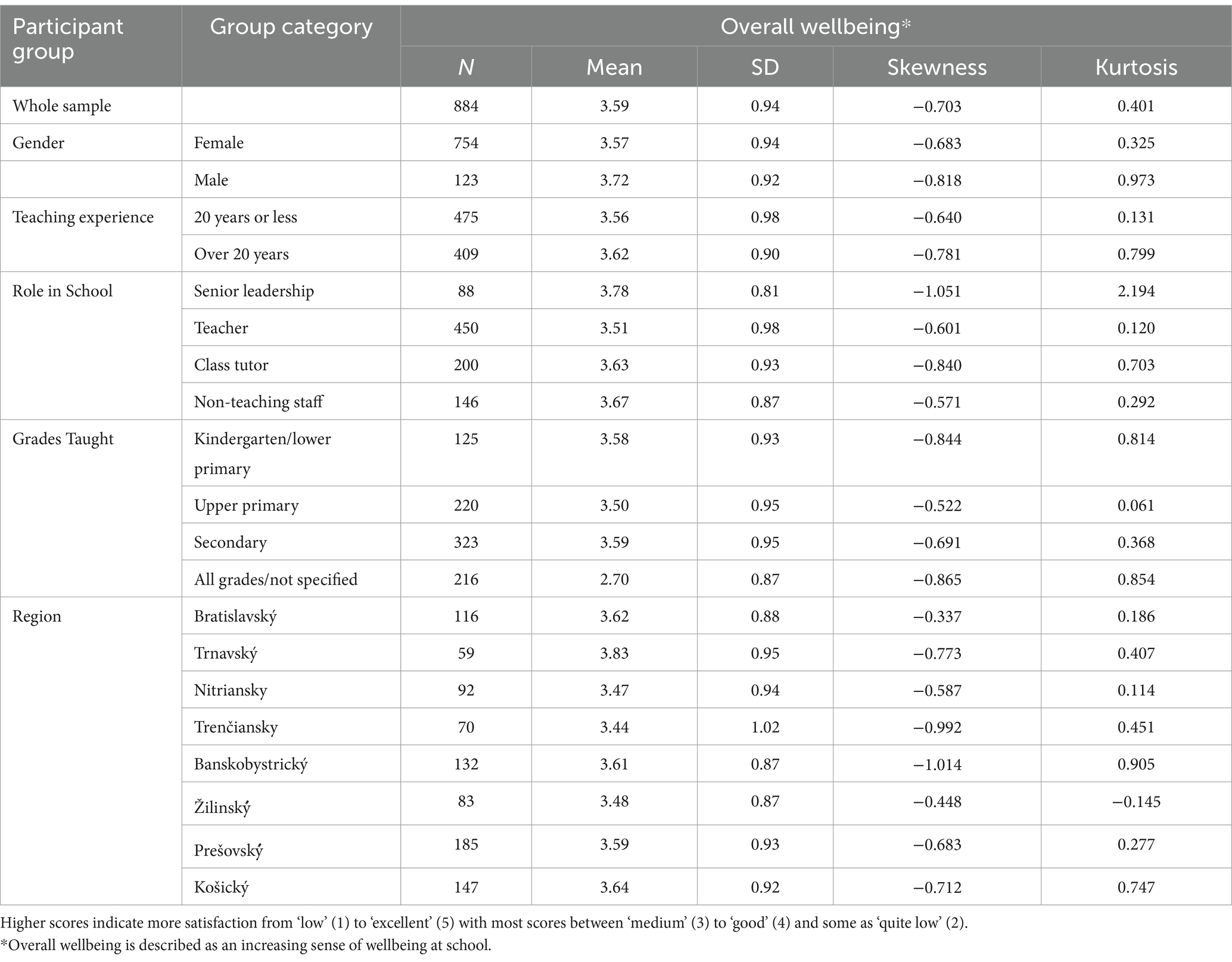
Table 5. Means, standard deviations and normality of reported overall wellbeing by the sample, gender, teaching experience, role in school, grades taught, and region of employment.
Table 6 shows the proportions of reported hedonic and eudaimonic wellbeing for the sample.

Table 6. Numbers and proportions of participants reporting frequencies of not enjoying time in school and reflecting on potential job performance improvement.
Table 6 illustrates that the most common position for respondents was to experience hedonic and eudaimonic wellbeing ‘occasionally.’ Table 6 expands on the previous results by presenting the mean values for the sample, along with those for various subgroups.
Table 7 shows that on average, positive emotional experiences outnumbered negative ones whilst reflecting on job performance was marginally more often detrimental than positive.
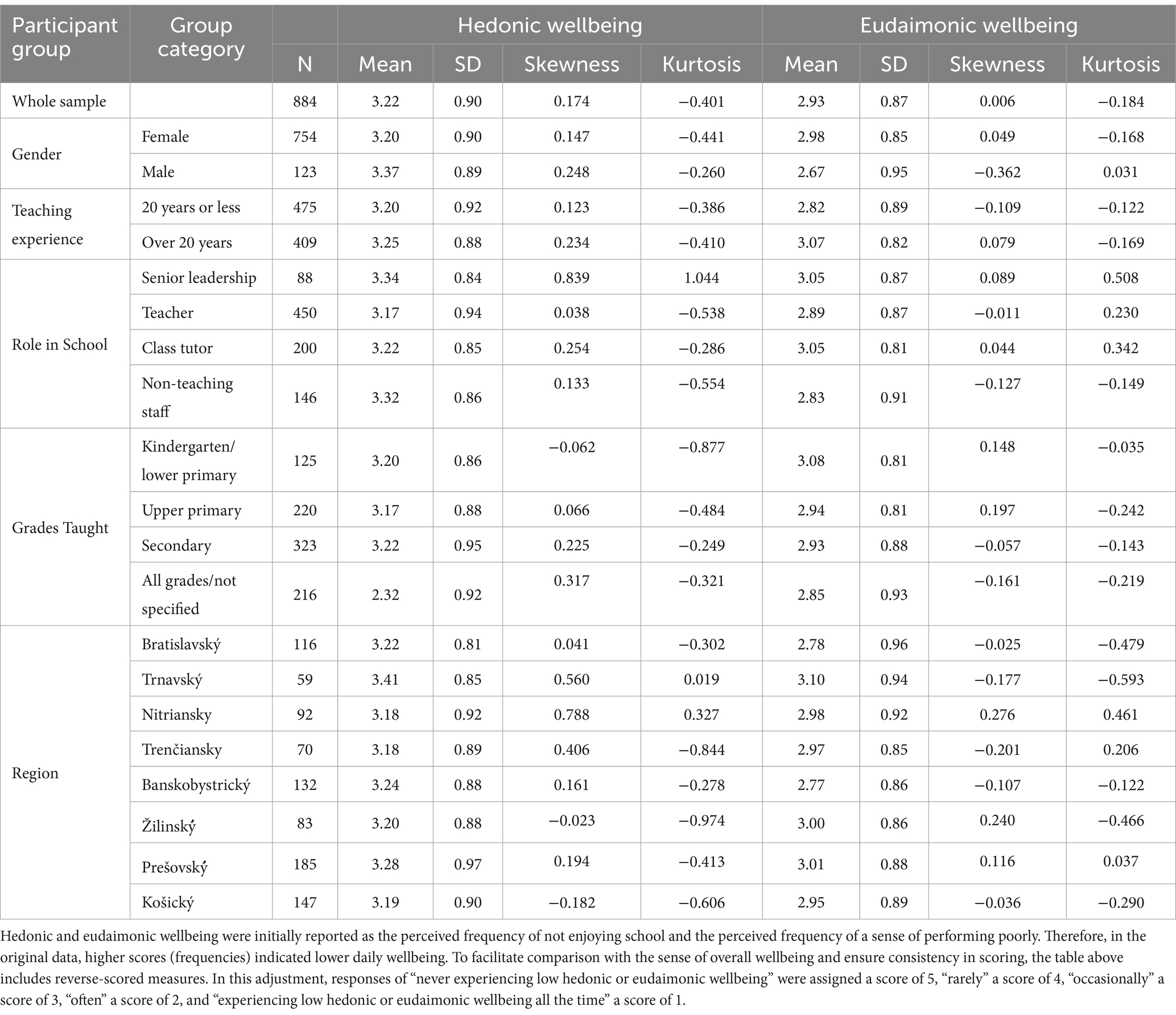
Table 7. Means, standard deviations and normality of positive hedonic and eudaimonic wellbeing for the overall sample and subgroups.
All values of skewness and kurtosis for the sample and its sub-groups for all three key variables related to wellbeing are < 2, as can be seen in Tables 4 and 6. This suggests the data meet the criteria for assumptions of normality (Kim, 2013) and therefore was taken forward for further inferential analyses.
The survey measured overall wellbeing as a sensation level rather than frequency of occurrence, treating the former as an independent variable and the two types of wellbeing as repeated measures. Our results show that a sense of overall wellbeing is strongly correlated with the frequency of experiencing hedonic wellbeing [R(884) = 0.70, p < 0.001], but not with eudaimonic wellbeing [R(884) = 0.06, n.s.]. This suggests that frequent positive emotional experiences in schools, rather than everyday satisfaction with job performance, are linked to a sense of overall wellbeing. However, despite the unclear connection with overall wellbeing, both types of wellbeing are significantly correlated with each other [R(884) = 0.12, p < 0.001], indicating that positive affect may stem from a sense of function, or vice versa.
4.2 Between group differences and interactions between variables
4.2.1 Group differences in wellbeing
Table 8 presents a summary of the one-way ANOVAs conducted to examine group differences. The one-way ANOVAs revealed that there was no significant effect of gender on overall wellbeing [F(1, 875) = 2.49, n.s.]. However, there was a significant effect of gender on eudaimonic wellbeing, F(1, 875) = 13.71, p < 0.001, and an approaching significant difference in hedonic wellbeing, F(1, 875) = 3.790, p = 0.052. Regarding eudaimonic wellbeing, male teachers (M = 2.67, SD = 0.95) were significantly more likely than female teachers (M = 2.98, SD = 0.85) to reflect badly on their practice. Yet, as some compensation, at the level of a trend, male teachers (M = 3.37, SD = 0.89) were more likely to report fewer instances of not enjoying being at school compared to female teachers (M = 3.20, SD = 0.90).

Table 8. One-way analyses of variance in wellbeing by independent variables of gender, teaching experience, grades taught, category of employment and region.
There was no significant effect of the level of teaching experience on overall wellbeing [F(1, 882) = 0.67, n.s.] or hedonic wellbeing, F(1, 882) = 0.79, n.s.]’ However, there was a highly significant effect F(1, 882) = 18.16, p < 0.001, of teaching experience on eudaimonic wellbeing, with more experienced teachers (M = 3.07, SD = 0.82) having better eudaimonic wellbeing compared to less experienced teachers (M = 2.82, SD = 0.89).
There was a significant difference in overall wellbeing based on category of employment [F(3, 880) = 2.90, p = 0.034] with post-hoc tests indicating that those in senior leadership roles (M = 3.34, SD = 0.84) reported better wellbeing than those employed as teachers (M = 3.17, SD = 0.94). There was no significant effect of role in hedonic wellbeing [(F3, 880) = 1.55, n.s.] however there was a significant effect for eudaimonic wellbeing [(F3, 880) = 2.88, p = 0.035] albeit with post hoc tests showing no one role was distinguishable from another other than at a general level.
A series of one-way ANOVAS showed that there were no significant group differences for grades taught or region for overall wellbeing, hedonic or eudaimonic wellbeing.
4.2.2 Interactions between variables
Regarding interactions, a MANOVA found a significant interaction between gender and teaching experience on eudaimonic wellbeing, F(1, 508) = 4.27, p = 0.039. There were no other significant interactions for pairs of variables. However, there was a significant interaction between gender, grades taught and region for hedonic wellbeing, F(8, 508) = 1.977, p = 0.047, and a four-way interaction between gender, teaching experience, grades taught and region for overall wellbeing, F(5, 508) = 3.034, p = 0.048. Figure 4 illustrates the interaction of gender with teaching experience for eudaimonic wellbeing.
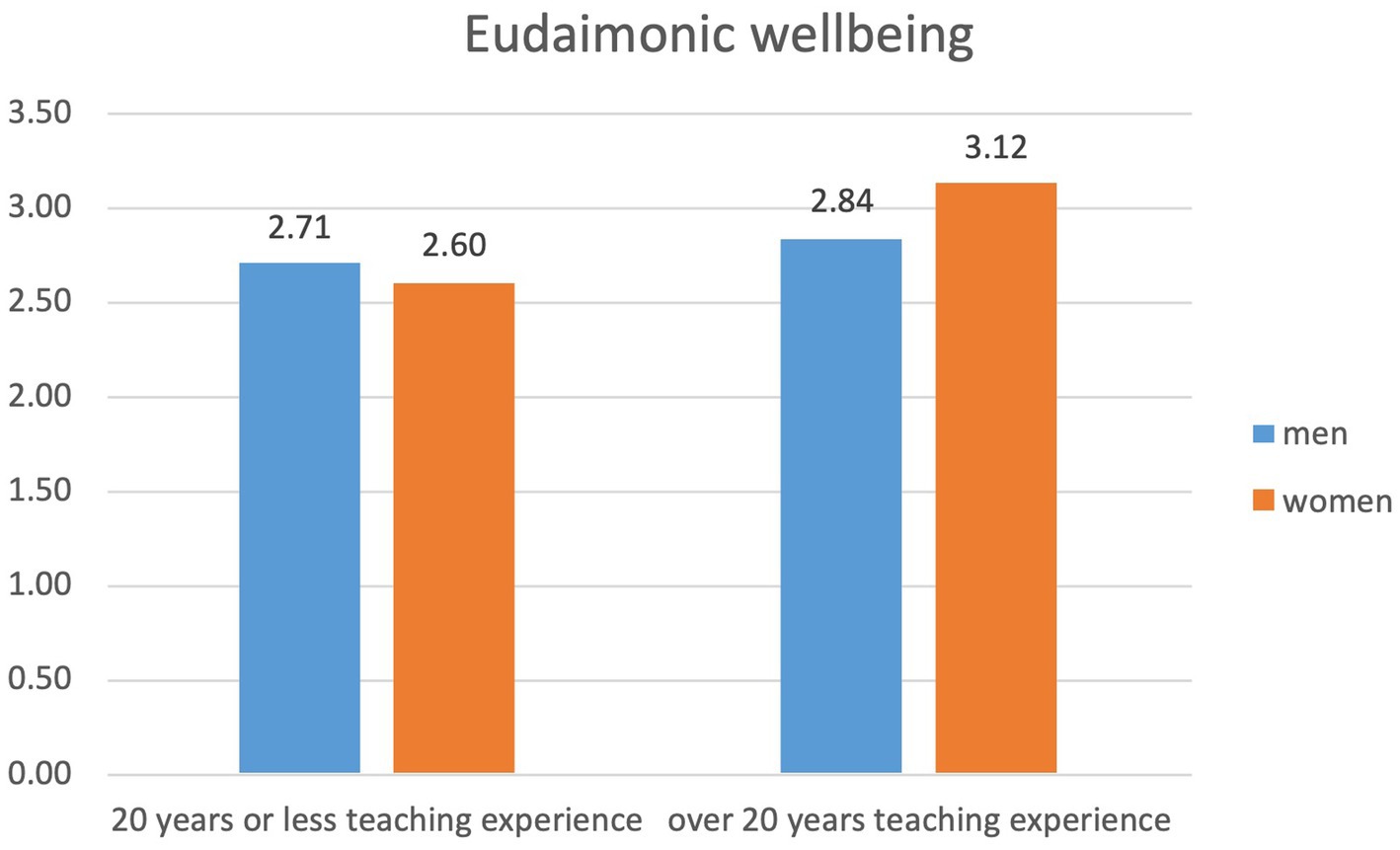
Figure 4. Mean frequencies of experiencing eudaimonic wellbeing by teaching experience (≤20 vs. >20 years) and gender.
The sample for male teachers in other than the secondary school grades meant that for some regions there were no primary and few lower secondary teachers so only the position for women teachers are illustrated. Figure 5 illustrates the interaction between grades taught and region for hedonic wellbeing. Figures 6 and 7 illustrate how teaching experience, grades taught and region interact for overall wellbeing.
Again, as too few male teachers responded for the lower grades in school, only the results from female teachers are shown with Figure 6 presenting the interaction by region for those with 20 years or less experience and Figure 7, for those with over 20 years’ experience.
4.3 Summary of levels and frequencies of occurrence of types of wellbeing
The main factor in overall wellbeing appeared to be the participant’s role in school with those in senior leadership roles reporting more satisfaction than those in teaching roles. This was reflected not necessarily in more enjoyment but in a sense of functionality.
Importantly to extend this insight, the above results indicate important differences in hedonic and eudaimonic wellbeing that are not always apparent with a simple measure of overall wellbeing. For example, gender is a primary factor in how frequently participants reported reflective dissatisfaction with their performances. Men displayed significantly less eudaimonic wellbeing than women, albeit this was countered by men’s superior hedonic wellbeing. This could be one feasible explanation as to why overall wellbeing was not significantly related to gender since personal frustrations could be mitigated by enjoyment.
A highly significant difference in eudaimonic wellbeing was apparent for teachers with more than 20 years of experience that is in line with growing self-efficacy over time. Yet, this did not translate to an improved sense of overall wellbeing or more regular enjoyment from their role. More detail on this main effect came from the interaction results where gender and experience interacted to suggest that this specific result was driven by the majority of the sample who were women. Men had a different trajectory to women regarding negative reflections on their performance as they did not improve their position in the way women did with career experience. Effectively, a small initial advantage in eudaimonic wellbeing for men was little improved over time whereas for women a sense of functionality grew significantly.
Thus, the interaction effects further reveal that the combination of gender with experience cannot be simply revealed with an overall measure of wellbeing or generalized by social group. It also appears some regions’ schools are more enjoyable places to work for women compared to men when the numbers for various grades allow comparisons, as the significant interactions reported previously suggest.
Our next section explores what supports teachers turn to and whom they consider as important to support their hedonic and eudaimonic wellbeing.
4.4 Sources and protective factors of teachers’ wellbeing
To understand the sources of teachers’ wellbeing, we explored to whom teachers attribute their hedonic and eudaimonic wellbeing experiences. We further enquired who do they approach for help to improve either aspect of their wellbeing experiences in schools. Figures 8 and 9 represent our findings for hedonic wellbeing—feeling good at school.
Teachers hold that their students, colleagues and themselves play key role in their emotional wellbeing experiences in schools.
When not feeling good at schools, teachers in Slovakia tend to turn to their colleagues or no one for support.
We assessed eudaimonic wellbeing in the same way. Figure 10 shows that most teachers find their students, themselves and their colleagues responsible for having a successful day.
Figure 11 displays who teachers approach for support when they want to perform better.
Colleagues, teachers’ own family members and school management are the most frequent sources for help, when teachers want to perform better at school.
5 Discussion
This study contributes to our understanding of wellbeing as an indicator of quality of life in a profession. First, it highlights the need to zoom in on employees’ appreciation of their emotional experiences or work satisfaction in their wellbeing self-reports. Existing assessment tools (e.g., Work Wellbeing Questionnaire by Parker and Hyett, 2011; Thriving at Work by Porath et al., 2012) assess wellbeing with a limited focus on either satisfaction about work fulfilment, optimal functioning, or work-related health. However, our results show that assessing emotional wellbeing is equally important, as it significantly impacts the overall quality of life.
From a theoretical point of view, this finding is not surprising, as the wellbeing construct involves both hedonic (emotion-based and life satisfaction) and eudaimonic (fulfilling life) appraisals (Ryan and Deci, 2001). In hedonic wellbeing, the prevalence of positive emotions over the negative ones is as important as overall life satisfaction (Diener et al., 1999). Therefore, considering only the work satisfaction and perceived meaningfulness does not assess wellbeing fully as emotional experiences are left out. The pivotal role of relatedness present in many theories of wellbeing is also not explicitly examined in such a succinct form as our research which shows how students as well as colleagues influence wellbeing alongside teachers garnering personal support from social connections outside school.
We offer two possible explanations for work wellbeing questionnaires not including emotions. The most obvious one is that omitting the role of emotions might feel natural within the work context. Rather than creating positive emotions, organisations primarily focus on generating revenue and outperforming competition, which cascades down to employee levels. Another explanation refers to wellbeing as a complex construct, which gets often reduced to life satisfaction. Here, Diener’s (1984) tripartite model helpfully includes life satisfaction together with emotional aspects of wellbeing. The model clearly distinguishes three wellbeing elements—positive affect, negative affect, and life satisfaction—contributing to overall wellbeing in unique ways (e.g., Diener, 1984; Diener et al., 1999). Therefore, they should be assessed and mapped out individually instead of adopting a global measure of happiness or life satisfaction (Diener et al., 1999). Although using a global wellbeing assessment seems practical, as our study confirms that emotional and cognitive appraisals can produce very different wellbeing reports.
In line with the mapping of wellbeing components individually, our second finding points at the importance of group differences within these components. Our study shows that the overall wellbeing of Slovak teachers was good with no significant gender differences. However, this result is a consequence of counteracting effects of hedonic and eudaimonic wellbeing—men enjoy school more but felt less satisfied with their performance whereas women do not enjoy being in school as much but are less concerned with their performance. This has implications for the potential targeting of professional development and welfare support.
So while our overall results confirm previous assessments of positive wellbeing among teachers in Slovakia (Boleková et al., 2022), we report that gender differences can reveal a different reality. Compared to female teachers, men in our sample seem to have more pragmatic approach to their daily wellbeing experiences at work. Men teachers are less likely to indicate not enjoying being at school and more often think of ways to improve their practice. While this distinction could be misinterpreted as tapping on the generic perception of women being more emotional, a recent study of Givon et al. (2023) reveals that women may simply be more efficient in being sensitive to and reporting negative emotions that consequentially could translate into seeing such signs in students.
An alternative explanation lies in gendered patterns of socialisation. Men are often encouraged to prioritise confidence and external composure over self-doubt or emotional introspection (Connell and Messerschmidt, 2005), which may make them less inclined to dwell on negative emotional experiences at work, thus reporting higher satisfaction. However, the greater tendency to reflect poorly on their professional performance may point to internalised pressures related to competence, authority, or performance expectations, especially in a profession traditionally dominated by women. These findings suggest that wellbeing is shaped not only by individual traits or workplace conditions, but also by the broader cultural narratives and gendered expectations that inform how teachers engage with their roles and evaluate their experiences.
In addition, our study highlights the importance of relationships as important risk and supportive factors for wellbeing and resilience. While relationships represent a key domain across wellbeing (Diener, 1984; Diener et al., 1999; Ryan and Deci, 2000) and Job Demand-Resource theory (Bakker and Demerouti, 2007; Demerouti et al., 2001), we contribute to the scholarship of wellbeing assessment at workplace by expanding relationships to outside of work (family and friends), spiritual relationships, and relationships with psychologists. Relationships are prevalent across wellbeing theories. They are included in the life satisfaction domains of Diener’s (1984) Tripartite model (Diener et al., 1999) of hedonic wellbeing. Additionally, the eudaimonic wellbeing model of Self-Determination Theory (Ryan and Deci, 2000) indicate that the need of relatedness is closely fulfilled by relationships, which also underpin the remaining needs of positive sense of autonomy and competence to experience a good life. Aligning with wellbeing theories, our findings expand the types of relationships beyond the context within which wellbeing assessment is conducted. We propose that the role of relationships in one’s wellbeing cannot be restricted by their nature and context.
5.1 Implications for practice
The findings from our study reveal essential insights at both hedonic and eudaimonic aspects of teacher wellbeing, indicating a distinct focus for organisational strategies. When subjective wellbeing reports emphasise a need for increased day-to-day happiness, organisations might need to concentrate on factors that enhance employees’ immediate joy and contentment at work. On the other hand, if the reports highlight a need meaningfulness and a sense of purpose in work, strategies should target improving the sense of employee’s intrinsic value and the significance of their role in shaping children, young people, and societal development.
To obtain this nuanced understanding of wellbeing, hedonic and eudaimonic wellbeing need to be assessed separately. This means that subjective wellbeing reports need to include both feeling good as well as functioning well indicators. Tools such as the Warwick-Edinburgh Mental Well-Being Scale (Tennant et al., 2007) allow for this distinguished mapping of wellbeing and showcase the importance of including the feel in the assessments of employees’ wellbeing. The tool assesses feelings (e.g., “I’ve been feeling cheerful”) in nine statements in its 14-item version and four times in the shorten 7-item scale (Tennant et al., 2007). Moreover, the tool has been validated internationally (e.g., Spain, Iceland) and with different groups (e.g., healthcare workers, veterinary professionals; the tool has not been validated in Slovakia).
Further examination of wellbeing should consider group differences such as years of service and gender, which can reveal the dynamic of wellbeing perceptions and identify target areas for specific groups. This is especially critical since more senior and experienced teachers have a higher sense of function than others and an overall measure of wellbeing could mask their disaffection. Conversely, the more junior and less-experienced staff enjoy their work more but have a lower sense of function. This needs further investigation since career dissatisfaction could feasibly drive attrition from the profession more than day to day enjoyment at a cost to students and the education system overall. There is much evidence that introducing empowering research-informed professional development programmes (e.g., Bergmark, 2020) that target younger members of the teaching profession and mentoring programmes can mitigate attrition (Hobson et al., 2009) suggesting Slovakia could consider supporting these approaches more as policy.
Beyond teachers, our findings resonate with broader organisational contexts, underscoring the importance of balancing broad-scale assessments with individualised approaches. While narrowed analyses of wellbeing domains, such as perceived autonomy and workload offer valuable insights, they can become circumstantial and impractical without further contextualisation. Engaging in one-on-one conversations can provide a more comprehensive and actionable understanding of individual wellbeing. Empowering individuals through research which they lead themselves can act to address the uniqueness of needs and this again can be encouraged through national policies such as, for example, encouraging professional learning communities (Admiraal et al., 2019) or Action Research Networks (Streck, 2014) extending beyond educational contexts to domains such as health (Santoro Lamelas, 2019). Indeed, action research initiatives and professional learning communities align with and endorse a bottom-up approach that our research sought to empahsise. By applying Bronfenbrenner’s theoretical lens to explicitly stratify sources of wellbeing support, our results seem to provide preparation not only use as a prompt in a single professional development programme adopting an experiential learning paradigm also have broader relevance for other types of professional development approaches.
Additionally, our findings highlight the significance of relationships outside workplace in contributing to employees’ wellbeing. Family and friends play crucial role in fostering employee wellbeing and resilience; therefore, organisations should embrace social interactions outside of work. Policies that promote family-friendly practices and opportunities for socialising can enhance employees’ overall wellbeing. As an example, Slovak state-governed organisations, including schools with declining and aging workforce, should take inspiration from international companies operating in the country. These multinational organisation continue to attract and retain employees by offering a range of family-friendly benefits, such as remote working, family sick days, family days at work, and other similar perks, in addition to competitive salaries and essential resources (e.g., laptop stations, stationery).
In summary, the practical implications of our study advocate for a dual approach to teacher and other professions wellbeing: broad, regular assessments to capture trends, and tailored, individualised conversations to address specific needs. Organisations should also recognise the integral role of external relationships in employee wellbeing and incorporate support mechanisms to bridge work and personal life.
5.2 Strengths, limitations, and future directions
Our study presents a comprehensive approach to mapping wellbeing within a specific profession, considering not just general indicators but also the emotional experiences and feelings individuals have while at work. A key strength of this research lies in its robust theoretical framework, drawing on the concepts of wellbeing, the Job Demands-Resources (JD-R) model, and Bronfenbrenner’s ecological systems theory.
Its methodological approach, particularly in identifying the needs of the population before planning a training programme, shows a strong example of good practice in research design. The study also brings attention to a group of professionals—teachers—whose role in transitioning education is often overlooked. It underscores the critical importance of supporting not only the wellbeing of teachers but also that of their students.
Despite its strengths, beyond checks on its demography, the study’s sample may not be fully representative, which is a common issue in survey research where respondents are biased towards interesting the topic. A more systematic approach to sampling could enhanced the study representativeness. Initiatives like the Coalition of Schools, which regularly assesses the wellbeing of their member schools, could serve as a model for more comprehensive data collection. Another notable example is Durikova’s Teacher Wellbeing Index 2021, an individual effort that is hard to consistently replicate due to challenges with costs and practicalities.
Furthermore, our study relies on cross-sectional data, limiting the ability to observe trends over time. To address this, we recommend more regular data collection, aligning with national and international initiatives. Governments in transitioning countries could get inspired by existing nationwide reports like the National Study of Health and Wellbeing in England (National Centre for Social Research, 2024) or participate in international efforts such as the European Social Survey (2024). These strategies would help reduce costs, ensure the quality of the tools used, and support comparisons with other countries.
6 Conclusion
Our study provides critical insights into how wellbeing and resilience needs can be succinctly but meaningfully measured, interpreted, and addressed within a profession. By focusing on Slovak teachers, we addressed an understudied national and educational context for wellbeing. We used a simple and accessible theoretical model of wellbeing, and identified the importance of distinguishing between hedonic and eudaimonic wellbeing. This approach accounted for self-perceived competence and affect, reflecting key factors in the teaching profession.
When examining wellbeing without reducing it to a single metric, our approach highlighted demographic differences such as gender, role and years of service, and underscore the importance of interpersonal relationships, both within and outside the workplace, in shaping teacher wellbeing. This learning emphasises the importance of work-life balance and policies that support social interactions.
By grounding the study in a national perspective, we created a foundation for a professional development programme that aligns with teachers’ social context and needs.
Overall, our research provides valuable guidance for decision-makers aiming to enhance employee wellbeing and resilience. By incorporating regular, broad-scale assessments alongside individualised conversations, organisations can better support their workforce. This study not only informs the design of wellbeing programmes for teachers but also offers a framework applicable to other professions, contributing to the broader discourse on wellbeing and resilience.
Data availability statement
Due to ethical and legal concerns, the research data supporting this publication cannot be made openly available. Anonymised data can be provided by the authors upon reasonable request.
Ethics statement
The studies involving humans were approved by Research Ethics Committee, School of Education, University of Exeter. The studies were conducted in accordance with the local legislation and institutional requirements. The participants provided their written informed consent to participate in this study.
Author contributions
LJ: Conceptualization, Funding acquisition, Investigation, Methodology, Project administration, Resources, Visualization, Writing – original draft, Writing – review & editing. LW: Conceptualization, Data curation, Formal analysis, Funding acquisition, Project administration, Resources, Software, Supervision, Visualization, Writing – original draft, Writing – review & editing.
Funding
The author(s) declare that financial support was received for the research and/or publication of this article. This study was funded by the Impact Accelerator Award of the Arts and Humanities Research Council [grant number 123168] in the United Kingdom.
Acknowledgments
The Social and Health Education Project, Ireland, and the Coalition of Schools for Mental Health [Koalicia Skol, Liga za Dusevne Zdravie], Slovakia, have kindly supported this study by reviewing the survey questions and promoting questionnaire. For the purpose of open access, the authors have applied a ‘Creative Commons Attribution (CC BY) licence to any Author Accepted Manuscript version arising from this submission.
Conflict of interest
The authors declare that the research was conducted in the absence of any commercial or financial relationships that could be construed as a potential conflict of interest.
Generative AI statement
The author(s) declare that no Gen AI was used in the creation of this manuscript.
Publisher’s note
All claims expressed in this article are solely those of the authors and do not necessarily represent those of their affiliated organizations, or those of the publisher, the editors and the reviewers. Any product that may be evaluated in this article, or claim that may be made by its manufacturer, is not guaranteed or endorsed by the publisher.
References
Admiraal, W., Schenke, W., De Jong, L., Emmelot, Y., and Sligte, H. (2019). Schools as professional learning communities: what can schools do to support professional development of their teachers? Prof. Dev. Educ. 47, 684–698. doi: 10.1080/19415257.2019.1665573
Asfahani, A. M. (2024). Link between job burnout antecedents and consequences: an empirical study on higher education faculty members in the Saudi context. J. Appl. Res. High. Educ. 16, 629–649. doi: 10.1108/JARHE-03-2023-0125
Bakker, A. B., and Demerouti, E. (2007). The job demands-resources model: state of the art. J. Manag. Psychol. 22, 309–328. doi: 10.1108/02683940710733115
Balberčáková, M., and Miklošovič, T. (2023), Prognóza počtu žiakov a učiteľov podla okresov doo roku 2030. Education Policy Institute. Commentary 01/2023. Available online at: www.minedu.sk/data/att/c51/25814.a49b30.pdf (Accessed January 26, 2025).
Ballova Mikuskova, E., and Veresova, M. (2020). Distance education during Covid-19: the perspectives of Slovak teachers. Probl. Educ. 21st Century 78, 884–906. doi: 10.33225/pec/20.78.884
Bauerova, L. (2024). Slovakia’s brain drain ‘picks up pace’ under populist leader Robert fico. The Guardian. Available online at: https://www.theguardian.com/world/2024/mar/30/slovakia-brain-drain-populist-leader-robert-fico (Accessed January 26, 2025).
Berger, E., Reupert, A., Campbell, T. C. H., Morris, Z., Hammer, M., Diamond, Z., et al. (2022). A systematic review of evidence-based wellbeing initiatives for schoolteachers and early childhood educators. Educ. Psychol. Rev. 34, 2919–2969. doi: 10.1007/s10648-022-09690-5
Bergmark, U. (2020). Teachers’ professional learning when building a research-based education: context-specific, collaborative and teacher-driven professional development. Prof. Dev. Educ. 49, 210–224. doi: 10.1080/19415257.2020.1827011
Birzea, C. (2012). Learning from post-communist transitions: The case of educational reforms in Central-Eastern Europe. London: Legatum Institute. Available online at: http://www.li.com/docs/default-source/future-of-iran/learning-from-post-communist-transitions-the-case-of-educational-reforms-in-central-eastern-europe.pdf?sfvrsn=2 (Accessed January 26, 2025).
Blanchflower, D. G., and Bryson, A. (2024). Wellbeing Rankings. Soc. Indic. Res. 171, 513–565. doi: 10.1007/s11205-023-03262-y
Boleková, V., Roľková, H., Majercakova Albertova, S., Szobiová, E., Radnóti, E., and Hennelová, K. (2022). Social-emotional health and resilience of teachers in Slovakia. Hum. Technol. Qual. Educ., 1135, 418–434. doi: 10.22364/htqe.2022.30
Boyle, G. J., Borg, M. G., Falzon, J. M., and Baglioni, A. J. Jr. (2015). A structural model of the dimensions of teacher stress. Br. J. Educ. Psychol. 65, 49–67. doi: 10.1111/j.2044-8279.1995.tb01130.x
Braun, S. S., Schonert-Reichl, K. A., and Roeser, R. W. (2020). Effects of teachers’ emotion regulation, burnout, and life satisfaction on student well-being. J. Appl. Dev. Psychol. 69:101151. doi: 10.1016/j.appdev.2020.101151
Briner, R., and Dewberry, C. (2007). Staff wellbeing is key to school success: A research study into the links between staff wellbeing and school performance. London: Worklife Support.
Bronfenbrenner, U. (1979). The ecology of human development. Cambridge, MA: Harvard University Press.
Bronfenbrenner, U., and Morris, P. A. (2007). “The bioecological model of human development” in Handbook of child psychology: Theoretical models of human development, vol. 1 (Hoboken, New Jersey: John Wiley & Sons Inc.), 793.
Byrne, J., Shepherd, J., Dewhirst, S., Pickett, K., Speller, V., Roderick, P., et al. (2015). Pre-service teacher training in health and well-being in England: the state of the nation. Eur. J. Teach. Educ. 38, 217–233. doi: 10.1080/02619768.2015.1030069
Cheng, H., Fan, Y., and Lau, H. (2023). An integrative review on job burnout among teachers in China: implications for human resource management. Int. J. Hum. Resour. Manag. 34, 529–561. doi: 10.1080/09585192.2022.2078991
Connell, R. W., and Messerschmidt, J. W. (2005). Hegemonic Masculinity: Rethinking the Concept. Gender & Society. 19, 829–859. doi: 10.1177/0891243205278639
Dagenais-Desmarais, V., and Savoie, A. (2012). What is psychological well-being, really? A grassroots approach from the organizational sciences. J. Happiness Stud. 13, 659–684. doi: 10.1007/s10902-011-9285-3
Darling-Hammond, L. (2017). Teacher education around the world: what can we learn from international practice? Eur. J. Teach. Educ. 40, 291–309. doi: 10.1080/02619768.2017.1315399
De Rose, A., Arezzo, M. F., Amore, M., Cuomo, A., De Filippis, S., La Pia, S., et al. (2023). Vulnerabilities in mental health due to Covid-19 pandemic: the response of the Italian physicians. Soc. Indic. Res. 168, 539–556. doi: 10.1007/s11205-023-03111-y
Demerouti, E., Bakker, A. B., Nachreiner, F., and Schaufeli, W. B. (2001). The job demands-resources model of burnout. J. Appl. Psychol. 86, 499–512. doi: 10.1037/0021-9010.86.3.499
Diener, E. (1984). Subjective well-being. Psychol. Bull. 95, 542–575. doi: 10.1037/0033-2909.95.3.542
Diener, E., Pressman, S. D., Hunter, J., and Delgadillo-Chase, D. (2017). If, why, and when subjective well-being influences health, and future needed research. Appl. Psychol. Health Well-Being 9, 133–167. doi: 10.1111/aphw.12090
Diener, E., Suh, E. M., Lucas, R. E., and Smith, H. L. (1999). Subjective well-being: three decades of progress. Psychol. Bull. 125, 276–302. doi: 10.1037/0033-2909.125.2.276
Doan, S., Steiner, E. D., Pandey, R., and Woo, A. (2023). Teacher well-being and intentions to leave: Findings from the 2023 state of the American teacher survey. Santa Monica, CA: RAND Corporation.
Doblytė, S. (2020). Shame in a post-socialist society: a qualitative study of healthcare seeking and utilisation in common mental disorders. Sociol. Health Illn. 42, 1858–1872. doi: 10.1111/1467-9566.13170
Dreer, B. (2023). On the outcomes of teacher wellbeing: a systematic review of research. Front. Psychol. 14:1205179. doi: 10.3389/fpsyg.2023.1205179
Ďuríková, K. (2021). Teacher wellbeing index Slovakia 2021. Bratislava, Slovakia: Konvalinka Institute.
European Commission (2023). Education and training monitor 2023: Slovakia. Directorate-general for education, youth, sport and culture. London, United Kingdom: Publication Office of the European Union. Available online at: https://op.europa.eu/webpub/eac/education-and-training-monitor/en/country-reports/slovakia.html (Assessed July 11, 2023).
European Social Survey (2024). European social survey as a European research infrastructure consortium: Revised and updated prospectus : City University of London.
Eurostat (2024). Classroom teachers and academic staff by education level, programme orientation, sex and age groups. EC Data Browser. Online data code: educ_uoe_perp01.
Executive Networks. (2022). Global chief human resource officers of the future research. Available online at: https://www.executivenetworks.com/wp-content/uploads/2022/09/CHRO-of-the-Future_eBook_FINAL.pdf (Accessed January 28, 2025).
Facchinetti, S., and Siletti, E. (2022). Well-being indicators: a review and comparison in the context of Italy. Soc. Indic. Res. 159, 523–547. doi: 10.1007/s11205-021-02761-0
Fernandez-Urbano, R., and Samuel, R. (2024). Youths’ perceived coping with the COVID-19 pandemic and subjective well-being: the moderating role of subjective social status. Soc. Indic. Res. 172, 803–830. doi: 10.1007/s11205-024-03307-w
Fernet, C., Guay, F., Senécal, C., and Austin, S. (2012). Predicting intraindividual changes in teacher burnout: the role of perceived school environment and motivational factors. Teach. Teach. Educ. 28, 514–525. doi: 10.1016/j.tate.2011.11.013
Fortune Business Insights. (2024). Market research: Corporate wellness market size: Global. (Report no 106931). Available online at: https://www.fortunebusinessinsights.com/corporate-wellness-market-106931 (Accessed January 28, 2025).
Gajdošová, E., and Majerčáková Albertová, S. (2019). Validation of international school climate surveys in Slovakia. Am. J. Appl. Psychol. 8, 14–18. doi: 10.11648/j.ajap.20190801.13
Gelencsér, M., Szabó-Szentgróti, G., Kőmüves, Z. S., and Hollósy-Vadász, G. (2023). The holistic model of labour retention: the impact of workplace wellbeing factors on employee retention. Admin. Sci. 13:121. doi: 10.3390/admsci13050121
Givon, E., Berkovich, R., Oz-Cohen, E., Rubinstein, K., Singer-Landau, E., Udelsman-Danieli, G., et al. (2023). Are women truly “more emotional” than men? Sex differences in an indirect model-based measure of emotional feelings. Curr. Psychol. 42, 32469–32482. doi: 10.1007/s12144-022-04227-z
Hajdu, D., Klingova, K., Szicherle, P., Kazaz, J., and Musilova, V. (2023). GLOBSEC trends 2023: United we (still) stand. GLOBSEC. Available online at: https://www.globsec.org/sites/default/files/2023-05/GLOBSEC%20Trends%202023.pdf (Accessed January 28, 2025).
Hanley, T., Winter, L. A., and Burrell, K. (2020). Supporting emotional well-being in schools in the context of austerity: an ecologically informed humanistic perspective. Br. J. Educ. Psychol. 90, 1–18. doi: 10.1111/bjep.12275
Harding, S., Morris, R., Gunnell, D., Ford, T., Hollingworth, W., Tilling, K., et al. (2019). Is teachers’ mental health and wellbeing associated with students’ mental health and wellbeing? J. Affect. Disord. 242, 180–187. doi: 10.1016/j.jad.2018.08.080
Haw, J. Y., Nalipay, M., and King, R. B. (2023). Perceived relatedness-support matters most for teacher well-being: a self-determination theory perspective. Teach. Teach. 30, 745–761. doi: 10.1080/13540602.2023.2263736
Helliwell, J. F., Layard, R., Sachs, J. D., De Neve, J.-E., Aknin, L. B., and Wang, S. (2024). World happiness report 2024. Oxford, United Kingdom: University of Oxford, Wellbeing Research Centre.
Hobson, A. J., Ashby, P., Malderez, A., and Tomlinson, P. D. (2009). Mentoring beginning teachers: what we know and what we don’t. Teach. Teach. Educ. 25, 207–216. doi: 10.1016/j.tate.2008.09.001
Horváthová, P., Kashi, K., Štverková, H., and Mikušová, M. (2021). Employee well-being evaluation and proposal of activities to increase the level of Health’s area—the Czech case. Admin. Sci. 11:17. doi: 10.3390/admsci11010017
Jerrim, J., Sims, S., Taylor, H., and Allen, R. (2020). How does the mental health and wellbeing of teachers compare to other professions? Evidence from eleven survey datasets. Rev. Educ. 8, 659–689. doi: 10.1002/rev3.3228
Jotkoff, E. (2022). NEA survey: Massive staff shortages in schools leading to educator burnout; alarming number of educators indicating they plan to leave profession. National Education Association. Available online at: https://www.nea.org/about-nea/media-center/press-releases/nea-survey-massive-staff-shortages-schools-leading-educator-burnout-alarming-number-educators (Accessed July 11, 2023).
Kim, H. Y. (2013). Statistical notes for clinical researchers: assessing normal distribution (2) using skewness and kurtosis. Restorat. Dent. Endodont. 38, 52–54. doi: 10.5395/rde.2013.38.1.52
Kim, J. (2021). The quality of social relationships in schools and adult health: differential effects of student–student versus student–teacher relationships. Sch. Psychol. Forum 36, 6–16. doi: 10.1037/spq0000373
Kolb, D. A. (1984). Experiential learning: Experience as the source of learning and development. Englewood Cliffs, NJ: Prentice-Hall.
Kovács, K., Dobay, B., Halasi, S., Pinczés, T., and Tódor, I. (2024). Demands, resources and institutional factors in the work of academic staff in central and Eastern Europe: results of a qualitative research among university teachers in five countries. Front. Educ. 8:1326515. doi: 10.3389/feduc.2023.1326515
Loinaz, E. S. (2019). Teachers’ perceptions and practice of social and emotional education in Greece, Spain, Sweden and the United Kingdom. Int. J. Emot. Educ. 1, 31–48. Available online at: https://files.eric.ed.gov/fulltext/EJ1213640.pdf
Lowry, C., Leonard-Kane, R., Gibbs, B., Muller, L.-M., Peacock, A., and Jani, A. (2022). Teachers: the forgotten health workforce. J. R. Soc. Med. 115, 133–137. doi: 10.1177/01410768221085692
Maas, J., Schoch, S., Scholz, U., Rackow, P., Schüler, J., Wegner, M., et al. (2022). Satisfying the need for relatedness among teachers: benefits of searching for social support. Front. Educ. 7:851819. doi: 10.3389/feduc.2022.851819
McGregor, A., Magee, C. A., Caputi, P., and Iverson, D. (2016). A job demands-resources approach to presenteeism. Career Dev. Int. 21, 402–418. doi: 10.1108/CDI-01-2016-0002
McMahan, E. A., and Estes, D. (2011). Hedonic versus eudaimonic conceptions of well-being: evidence of differential associations with self-reported well-being. Soc. Indic. Res. 103, 93–108. doi: 10.1007/s11205-010-9698-0
Mérida-López, S., and Extremera, N. (2020). The interplay of emotional intelligence abilities and work engagement on job and life satisfaction: which emotional abilities matter most for secondary-school teachers? Front. Psychol. 11:563634. doi: 10.3389/fpsyg.2020.563634
National Centre for Social Research. (2024). National Study of health and wellbeing 2023. Available online at: https://natcen.ac.uk/wellbeing (Accessed January 28, 2025).
Niemiec, C. P., and Ryan, R. M. (2009). Autonomy, competence, and relatedness in the classroom: applying self-determination theory to educational practice. Theory Res. Educ. 7, 133–144. doi: 10.1177/1477878509104318
OECD. (2018). TALIS 2018 Country Note: Slovak Republic. Available online at: https://www.oecd.org/education/talis/TALIS2018_CN_SVK.pdf (Accessed January 26, 2025).
Ozturk, M., Wigelsworth, M., and Squires, G. (2024). A systematic review of primary school teachers' wellbeing: room for a holistic approach. Front. Psychol. 15:1358424. doi: 10.3389/fpsyg.2024.1358424
Parker, G. B., and Hyett, M. P. (2011). Measurement of well-being in the workplace: the development of the work well-being questionnaire. J. Nerv. Ment. Dis. 199, 394–397. doi: 10.1097/NMD.0b013e31821cd3b9
Porath, C., Spreitzer, G., Gibson, C., and Garnett, F. G. (2012). Thriving at work: toward its measurement, construct validation, and theoretical refinement. J. Organ. Behav. 33, 250–275. doi: 10.1002/job.756
Price, D., and McCallum, F. (2015). Ecological influences on teachers’ well-being and “fitness.”. Asia Pac. J. Teach. Educ. 43, 195–209. doi: 10.1080/1359866X.2014.932329
Raymond, S., and Gabriel, F. (2023). An ecological framework for early years teacher self-efficacy development. Teach. Teach. Educ. 132:104252. doi: 10.1016/j.tate.2023.104252
Rutkowska, A., Liska, D., Cieślik, B., Wrzeciono, A., Broďáni, J., Barcalová, M., et al. (2021). Stress levels and mental well-being among Slovak students during e-learning in the COVID-19 pandemic. Healthcare (Basel, Switzerland) 9:1356. doi: 10.3390/healthcare9101356
Ryan, R. M., and Deci, E. L. (2000). Self-determination theory and the facilitation of intrinsic motivation, social development, and well-being. Am. Psychol. 55, 68–78. doi: 10.1037/0003-066X.55.1.68
Ryan, R. M., and Deci, E. L. (2001). On happiness and human potentials: a review of research on hedonic and eudaimonic well-being. Annu. Rev. Psychol. 52, 141–166. doi: 10.1146/annurev.psych.52.1.141
Ryff, C. D., and Keyes, C. L. M. (1995). The structure of psychological well-being revisited. J. Pers. Soc. Psychol. 69, 719–727. doi: 10.1037/0022-3514.69.4.719
Santoro Lamelas, V. (2019). The practice of action research on health in Latin America: a systematic review. Educ. Act. Res. 28, 293–309. doi: 10.1080/09650792.2019.1566083
Skaalvik, E. M., and Skaalvik, S. (2011). Teacher job satisfaction and motivation to leave the teaching profession: relations with school context, feeling of belonging, and emotional exhaustion. Teach. Teach. Educ. 27, 1029–1038. doi: 10.1016/j.tate.2011.04.001
Skaalvik, E. M., and Skaalvik, S. (2014). Teacher stress and teacher self-efficacy as predictors of engagement, emotional exhaustion, and motivation to leave the teaching profession. Creat. Educ. 7, 1785–1799. doi: 10.4236/ce.2016.713182
Slovak Academy of Sciences. (2020). Koronavírus zasiahol duševné zdravie mladých: hlásia viac depresií a úzkostí [Coronavirus has affected mental health of youth: reports on rise in depression and anxiety]. Available online at: https://www.sav.sk/index.php?doc=services-news&source_no=20&news_no=8928 (Accessed July 04. 2023).
Slovakia Ministry of Education. (2023). Komentár 04/2023 - Už mi, lásko, není dvacet let: Starnutie učiteľskej populácie. [Commentary 04/2023 – I’m no longer 20-years-old, love: The aging of teaching population.] The Ministry of Education, Research, Development and Youth of the Slovak Republic. https://www.minedu.sk/komentar-042023-uz-mi-lasko-neni-dvacet-let-starnutie-ucitelskej-populacie/
Streck, D. R. (2014). Knowledge and transformative social action: the encounter of selected traditions of participatory (action) research. Glob. Soc. Educ. 12, 457–473. doi: 10.1080/14767724.2014.901907
Suárez-Albanchez, J., Jimenez-Estevez, P., Blazquez-Resino, J. J., and Gutierrez-Broncano, S. (2022). Team autonomy and organizational support, well-being, and work engagement in the Spain computer consultancy industry: the mediating effect of emotional intelligence. Admin. Sci. 12:85. doi: 10.3390/admsci12030085
Tennant, R., Hiller, L., Fishwick, R., Platt, S., Joseph, S., Weich, S., et al. (2007). The Warwick-Edinburgh mental well-being scale (WEMWBS): development and UK validation. Health Qual. Life Outcomes 5:63. doi: 10.1186/1477-7525-5-63
United Nations. (2022). The Sustainable Development Goals Report 2022. Available online at: https://unstats.un.org/sdgs/report/2022/The-Sustainable-Development-Goals-Report-2022.pdf (Accessed Jul 11, 2023).
United Nations Refugee Agency. (2024). Regional refugee response plan - 2024 Slovakia chapter. Available online at: https://data.unhcr.org/en/documents/details/106245 (Accessed January 26, 2025).
VanderWeele, T. J., Trudel-Fitzgerald, C., Allin, P., Farrelly, C., Fletcher, G., Frederick, D. E., et al. (2020). Current recommendations on the selection of measures for well-being. Preven. Med. 133:106004. doi: 10.1016/j.ypmed.2020.106004
World Health Organization. (2023). Achieving well-being: A global framework for integrating well-being into public health utilizing a health promotion approach. Geneva: WHO. Available online at: www.who.int/publications/m/item/wha-76---achieving-well-being--a-global-framework-for-integrating-well-being-into-public-health-utilizing-a-health-promotion-approach (Accessed January 28, 2025).
Keywords: eudaimonic and hedonic wellbeing, teacher wellbeing, quality of life in school, resilience, online survey, education system, professional development, Slovakia
Citation: Janik Blaskova L and Winter L (2025) Mapping teacher wellbeing in Slovakia: insights into resilience, relationships, and support needs. Front. Educ. 10:1584696. doi: 10.3389/feduc.2025.1584696
Edited by:
Sarfraz Aslam, UNITAR International University, MalaysiaReviewed by:
Elizabeth Fraser Selkirk Hannah, University of Dundee, United KingdomAbdirahman Ibrahim Abdi, SIMAD University, Somalia
Copyright © 2025 Janik Blaskova and Winter. This is an open-access article distributed under the terms of the Creative Commons Attribution License (CC BY). The use, distribution or reproduction in other forums is permitted, provided the original author(s) and the copyright owner(s) are credited and that the original publication in this journal is cited, in accordance with accepted academic practice. No use, distribution or reproduction is permitted which does not comply with these terms.
*Correspondence: Lenka Janik Blaskova, bGVua2EuamFuaWsuYmxhc2tvdmFAdW5pYmEuc2s=
 Lenka Janik Blaskova
Lenka Janik Blaskova Liz Winter
Liz Winter